#there is more nuance to their dynamic than my art ever gives them credit for thats just an essay for another time.
Explore tagged Tumblr posts
Text

alexa play victorious by panic! at the disco
#fallout#fallout new vegas#benny gecko#courier six#fnv#this is just a dump of stuff i cant justify uploading individually or that im sick of sitting on my hard drive lololol#maybe i'll finish some of it someday. who knows#there is more nuance to their dynamic than my art ever gives them credit for thats just an essay for another time.#and nobody askng to see that shit lmfao#im just not a very good Artiste#my art
145 notes
·
View notes
Text
cdrama rec/review: go ahead
KDRAMA AND CDRAMA MASTER LIST OF REVIEWS
Series: go ahead Episodes: 40 Genres: family, healing/melodrama, slice of life, romance Spoilers in the Rec: for the first 20% ish/set-up If You Like, You’ll Like: reply 1988, le coup de foudre, find yourself (same production company/main male actor), rain or shine/just between lovers, found family stories, meet again stories
Rank: 10/10** (see Drawbacks section)
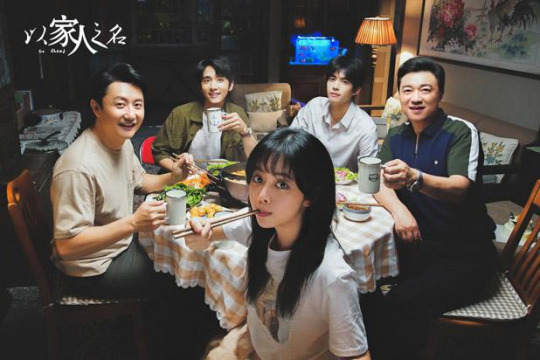
PREMISE
widower hai chao and his 6 year old daughter jian jian live happily above his noodle restaurant despite the recent, tragic death of his wife. one day, dysfunction junction a married couple (he ping, a police officer, and chen ting, a real piece of work) move into the same building with their 7 year old son, ling xiao. immediately, jian jian attaches herself to ling xiao, who is unexpectedly grim for a small child.
because ling xiao’s family is less-than-healthily grieving the loss of their youngest child, ling xiao’s sister who died in a terrible accident. The Apartment of Unhealthy Coping Mechanisms eventually implodes, ending with chen ting abandoning her husband and son. he ping, suddenly a single father, and hai chao come to a friendly partnership that is clearly alluding to gay marriage where they co-raise both of their kids--hai chao as the primary caregiver, and he ping supporting them financially through his job as a policeman.
meanwhile, the neighborhood busybody is dead-set on getting hia chao remarried. eventually she introduces him to a divorced single mother, he mei, and her son zi qiu, who is ling xiao’s age. they sort of start to date, but it culminates in he mei skipping town and leaving zi qiu behind. hai chao, man with a heart of gold, informally adopts him and zi qiu becomes jianjian’s foster brother.
from there, the trio grow up happily and become inseparable. but once zi qiu and ling xiao graduate high school, the bullshit parade their respective childhood skeletons reappear in their lives. circumstances lead to the boys moving overseas, leaving jianjian and their fathers behind.
they reunite after 9 years, when the boys return to a home where they hope to pick things back up from where they left off. things are more complicated than that, as jianjian finds herself in a new life and surrounded by new people.
MAIN CHARACTERS
li jian jian
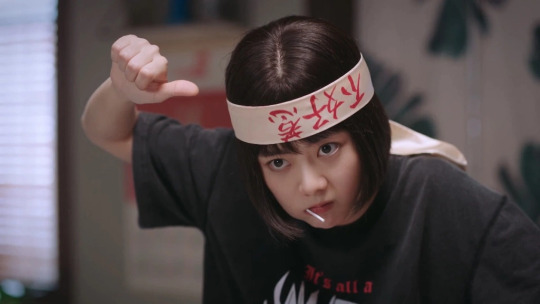
hai chao’s daughter and the only girl in the family. she attended the required short-hair-low-grades training program required of all cdrama youth female leads. super positive and outgoing, as well as the youngest of the three pseudo-siblings, jian jian grows up spoiled and over protected by her father and brothers, and as a result is completely devastated once her family falls apart. it’s so sad.
after the time skip, she’s an on-the-verge successful artist who makes woodcarvings, and exudes big art bro energy. inhales sugar like it’s nobody’s business. she inherited her father’s disease called caring too much, and it’s incurable!!
ling xiao

the eldest brother and resident fun police. ling xiao comes from a seriously toxic home that finally seems to improve once his mother leaves. but then she comes back. fucking great. introverted to the point of being withdrawn to anyone but his chosen family, ling xiao’s had to carry a lot of emotional weight that takes a larger and larger toll on him as the series progresses. please get this boy some therapy.
becomes a dentist because jian jian needs one. wears a lot of monochromatic outfits with low necklines because heavy angst but make it fashion. has been in love with jian jian since high school and is still carrying that torch 9 years later.
he zi qiu

the middle child who grows up in hai chao and jian jian’s home, and is her foster brother in all but paperwork. hotheaded, zi qiu and jian jian basically share two brain cells that ling xiao routinely takes from them for safekeeping. he spoils jian jian, sneaking her snacks and junk food and wants to become a pastry chef so he can open a sweet shop for her!!
my favorite character. just wants to be wanted 8( him and hai chao’s relationship is my favorite dynamic in the series. will sob while driving a pink moped. is too proud to beg
li hai chao (left) and ling he ping (right)
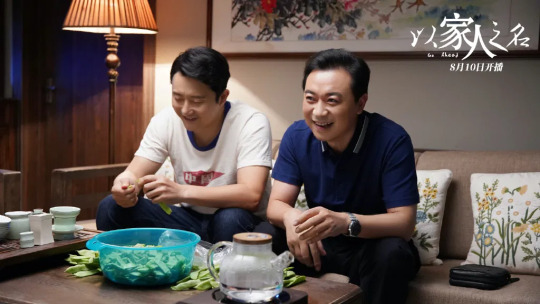
the greatest (hai chao) and okayest (he ping) dads in the world! noodle dad/hai chao has never done anything wrong in his life, ever, and we know this and we love him. he ping isn’t a bad person, but demonstrates pretty classic absentee parenting/isn’t as emotionally present in his son’s life as hai chao. hai chao is the heart of the family, and would do anything for his kids 8(
SOME SUPPORT CHARACTERS
tang can (left) and qiu ming yue (right)
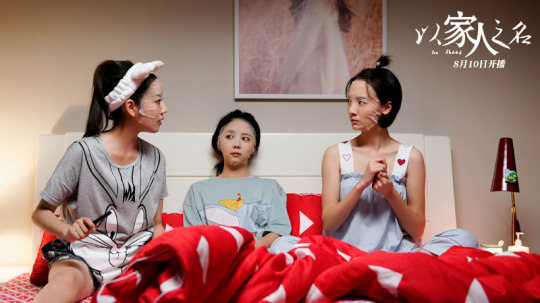
jian jian’s #GirlGang and roommates. they, like literally everyone in this drama, have some severe mom issue hang-ups. tang can (left) is a former child actress who is struggling with her lack of success as an adult and gives well-meaning but absolutely terrible advice on the regular.
ming yue (right) is jian jian’s best friend since childhood and as an adult is trying to break free from her mother’s controlling nature--she’s also had a thing for ling xiao for the last 9 years. raises fish for symbolism purposes.
chen ting

ling xiao’s mom and certified garbage human. unable to cope with the death of her daughter that was her fault lbr, she abandons her family and disappears for ten years. she forces her way back into ling xiao’s life when he turns 18, where it’s revealed that she’s remarried and ling xiao has a younger half-sister chengzi (”little orange”). shit goes down, and soon ling xiao is forced to move back to singapore to serve as primary caregiver to both his mother who abandoned him and the half sister he barely knows.
emotionally abusive and basically hits every single square on the toxic parent bingo card. i just. i just hate her. even typing this out is making me mad.
he mei

zi qiu’s mother. after a few dates with hai chao, she ends up ditching her kid and disappearing for unknown reasons. is a slightly better parent than chen ting but that’s like saying some poison kills you slower. the show tries to bring us around on her but it didnt work for me.
SOME OTHERS
zhuang bei, zi qiu’s best friend growing up who i would like a lot less if he wasn’t played by the same actor who played my beloved dachuan
zheng shuran, jian jian’s first boyfriend and fellow artist who’s got a weird thing for women’s waists and pretentious artists’ statements
du juan, jian jian’s friend who co-owns their woodworking studio. has absolute trash taste in men
chengzi, ling xiao’s half-sister who can be a brat but dear god does she need to be protected/saved
**DRAWBACKS
so this is a weird one for me. what i didn’t like i really didn’t like, but what i loved i really loved. ultimately, the factors/uniqueness of this show and the loveability of the main characters outweighed the negatives and it’s one of my favorite dramas.
THAT SAID. i got some #thoughts on this one.
first, there are literally no positive mother figures in this show. not a damn one. they are all negligent or controlling at best or down right abusive at worst. no woman over 30 is portrayed positively and that’s a big No from me.
the last 10 eps have some pacing issues and focus on the wrong people. spending the remaining episodes focused on one of the most universally hated characters vs. the main family was a bad move
the show tried to redeem or make us sympathize with characters that were, to me, completely irredeemable. one case is worse than the other, but both of them were terrible people that deserved to be cut out of the main family’s lives.
REASONS TO WATCH
the main family. the characters are so wonderful and nuanced, and their dynamics with one another were amazing. you’ll fall in love with hai chao aka noodle dad and the trio. they go through so many trials but they still stick together and it’s ultimately a healing drama and i loved it very much.
the central romance was less in focus, but the pining is enough to make jane austen emerge from the grave. i loved the leads together, and while LOL ling xiao’s attachment to jian jian was not always healthy, they supported each other and it made me smile. i love me a tortured pining dude.
#Acting. everyone played their parts to perfection. the child actors in particular were so well-cast (esp baby zi qiu)
the soundtrack lmao. you watch the opening credits and know you’ll need to buckle up
idk it’s a very unique show, and i haven’t seen one like it. reply 1988 comes close, but it doesn’t tackle the same issues and it was all just very real and earnest.
Final Thoughts.
GOODNIGHT, GOOODBYYYYYE MY CHILDREEEEEEEN

99 notes
·
View notes
Text
LGBTQ Light Novel Review - Sexiled Vol. 1

When J-Novel Club announced that they would be releasing Ameko Kaeruda’s light novel Sexiled: My Sexist Part Leader Kicked Me Out, So I Teamed Up with a Mythical Sorceress! I remember seeing some backlash on Twitter for the main title and cover art of the Sorceress, Laplace, exposing a solid third of breasts in a tight black dress. However, I dug a bit deeper into the work (because it is my job to do so) and was very excited at the prospective plot of women kicking ass, kissing girls, and fighting the patriarchy. After reading Sexiled, I am thrilled to say that my expectations were not only met, but exceeded by the length of a massive and impractical anime sword. This book is an excellent work of feminist literature and one of the best light novels I have ever read.
As the long title suggests, the story begins when Tanya Artemiciov, a prodigious mage, is fired from her adventuring party by its leader Ryan. The slimy, sexist, and cowardly antagonist of the book. Outraged, Tanya sets out to the wasteland to blow off steam in a spectacular and curse-riddled manner, when she accidentally releases Laplace, an ancient sorceress sealed away for centuries. After besting Laplace, the two women agree to form a party to enact sweet revenge against Ryan and take down the patriarchal society while they are at it.The story is not subtle at all with its mean themes. From the start, it is clear to the reader that sexist ideas dominate this society. Everything in the story, from the comments men make, “us men are just naturally better equipped for the job” to the oversexualized garments female adventurers are forced to wear, trace back to sexism. Great credit must be given to Kaeruda here, as the examples and instances of sexism are all taken from reality. The scores of female applicants to the mage’s school being docked mirrors last year’s scandals of Tokyo Medical School. Female adventurers are paid less and expected to retire early to start families, reflected the treatment of women in the corporate world. A full comparative list would easily take up half this review.
Not only are so many issues of sexism identified and explored in the light novel, but they are also each confronted by the heroes. Sexiled’s world and characters are typical of a power fantasy series. The protagonist is leagues stronger than anyone else, and the world has game-like qualities, with classes and levels. However, unlike the typical annoying male protagonist whose best defining character trait is “exists,” the women in Sexiled use their incredible powers to obliterate the oppressive systems. It is a pure indulgence to read, as there are few experiences more satisfying than reading descriptions of god-tier characters destroy selfish, egotistical, and demeaning men.
The sexist setting is the main focus of the story, which makes some of the plotlines predictable. However, there is a surprising amount of nuance in some of the issues presented. Tanya has lived her whole lives in this society and is thus blinded to the harsh reality and unfair circumstances around her. One of my favorite moments sees the women discussing armor and how revealing and sexual clothing is demeaning when forced, and empowering when chosen:
“‘Um, Laplace? You forgot to cover up your, uh… chest area.’ Hmm? Why should I?’ ‘Well, weren’t you saying we don’t need to show skin?’ ‘Correct–we don’t need to. But in this case, I want to.’”
Unfortunately, the plot is a bit monotonous. The one-note that is it, powerful women using magic to fight against sexism, is a superb one, but I would have liked to see a bit of variety or actions taken by women that were not solely motivated by men. It is disappointing to see that all the actions taken are in response to the atrocities of society, especially considering how feminist the book is. The points, while important, are merely the blemishes on a masterful work of art and culture. Sexiled remains one of the most engaging, fun, and relevant visual novels on the market.
Speaking of light novels, I have to mention and praise the prose in Sexiled. Usually, the writing in light novels is tolerable at best, and agonizing at worst. However, Kaeruda and the English translator Molly Lee, have done the unthinkable, crafting a light novel that is not only easy but enjoyable to read. Everything from the wonderful descriptions, entertaining dialogue, clever references, and wondrous use of profanity are highly polished and well crafted. A particular favorite of mine is Tanya’s incantation for the spell explosion, “From twilight, I summon the ultimate f***ing destruction! Ashes to ashes, dust to dust; heed my call and unleash your f***ing might! F*** this s***!” Sexiled has become the new bar for light novel localizations! A complete side note, Lee is also translating Seven Sea’s English adaption of the Adachi and Shimamura light novels, which gives me such hope for that series. Before I sing any more praises of Lee and Kaeruda, I should talk about the characters.
Both the main characters in Sexiled are lovely. Tanya is confident, powerful, kind, and a hilarious drunk. She seamlessly transitions between ruthlessness in battle to loving and compassionate when speaking to her friends. However, she never loses the sharp wit that helps her stay refreshing and hilarious. While I adore her, I am entirely entrenched by Laplace, who also goes by some fantastic pseudonyms, including “the Wicked Dragonwhore” and “Stone Cold Stunner.” She has an immense amount of self-confidence and an irresistible bravado. She is also very playful and enjoys teasing Tanya. The interactions between these two make for some of the best moments in the volumes:
“‘That look on your face says you think I’m nothing more than a human-shaped balloon.’ ‘Damn right!’ ‘Wow… I wish you would’ve at least tried to deny it…” They are perfect together.
Many of the female side characters have equally precise and detailed treatments. Nadine Amaryllis, a low-level healer that joins the girls’ party, is likable and has a comprehensive and dramatic backstory that functions as one of the work’s best reveals. Additionally, the minor villain, Katherine Foxxi, is one of the more dynamic characters. She starts blind to the sexism in her world but slowly changes throughout the novel. Unfortunately, Foxxi is also the focal point for one of the book’s only bad sequences. I would not be surprised to see a full redemption story or maybe an anti-hero persona for her in future volumes. However, the male villains are decidedly shallow. In fact, there is not a single half-decent, or even well-intentioned man present in the story. I do not mind, but it is a bit suspect. Other light novels have had similar villains and themes while still allowing for nuance and avoiding stereotyping an entire demographic.
The yuri elements in Sexiled are pretty minimal. Most of the story focuses on the women’s’ quest for revenge and their fight against the patriarchy, leaving little room for romance. There are a few light service moments where Laplace kisses Tanya, such as when she unlocks the mage’s full potential, but other than that, there is no physical contact. However, the strong bonds between the characters are apparent, and they all share a few touching scenes before the final chapters. A particular favorite of mine is Laplace using magic to make Nadine fly. There are also clear indications that the characters have multiple targets for their affections. Both Laplace and Tanya are implied to have interest in Nadine, as well as each other, thus sewing seeds for future romantic plots. While subtle, intense romantic relationships are present, and they add to the story while never distracting readers from it, which is a massive plus.
Sexiled: My Sexist Party Leader Kick Me Out, So I Teamed Up With a Mythical Sorceress! is an absolute must-read. The detailed and phenomenal writing is matched beautifully with strong female characters, hilarious dialogue, and exceptionally satisfying moments. It manages to expose the flaws of our society while providing an escape for those who suffer because of them. It does not make any profound or unique statements but allows the reader to revel in its indulgences. Sexiled is a spectacular masterpiece of fantasy and feminism that far outpaces other works in its genre and medium. This book is easily a new obsession of mine, and I cannot wait for the English release of volume two.
Ratings: Story – 10 Characters – 9 LGBTQ – 3 Lewd – 2 Final – 9
You can purchase Sexiled digitally now on Amazon: https://amzn.to/2J14WCj
Review copy provided by J-Novel Club
#yuri#reviews#lgbt#lgbtq#femnism#feminist#sexiled#queer#manga#light novel#anime#literature#wlw#fantasy#gay#lesbians
874 notes
·
View notes
Text
Cyberpunk 2077: Is This To Be An Empathy Test?
Cyberpunk 2077 is an adaptation and extrapolation of the popular tabletop pen-and-paper role-playing game Cyberpunk, originally published in 1988. The video game uses an extrapolation of the setting and Interlock system, translated to video game format.
When I finished the game, credits rolled. And rolled. And rolled. More than 15 minutes went by.
Now, days later, as I reflect on more than 70 hours of playtime, Cyberpunk 2077 feels like many people have had their hands in the pie. Its strengths and weaknesses stem from its massive ambition, marketing, and promises.
Different Experiences
I played CP2077 on a Ryzen 7 3700x with 32 gigs of RAM and an RX 2700 GPU. I was able to get around 35 FPS at 1440p without noticeable drops (except when looking in mirrors), and I played on ultra-settings without ray tracing on. I began playing it with the rest of the PC consumers with the day 1 patch.
As a crafted experience, I can say that it is the most impressive looking game I've ever played, and my playthrough seems to be a fortunate one, with maybe a handful of glitches or bugs across the entire 70 hours. None of which were remotely game-breaking. I was never unable to progress in the story. I never had a crash. The most annoying thing I experienced was sometimes crosshairs from a gun would continue to stay onscreen after it was holstered.
I mention this because I think a major component of why I come away with a positive experience is because my computer could deliver the intended experience. And Cyberpunk 2077 is unrivaled in its execution of a funneled narrative. Characters and environments have never felt more genuine and cinematic.
The sound design is some of the best I've heard, and it's perfect in every aspect of the game. From the sound of a throaty exhaust to the scraping of metal-tipped hands against hardwood, the sound is superb and adds to the immersion.
The World
With a setting as old as Cyberpunk, there will be consumers who are familiar with the setting and have a grasp on the worldbuilding. For the uninitiated, however—of which, I think most customers will be—the aesthetic and gameplay elements the marketing team used in advertisements will be the primary hook. The game doesn’t go out of its way to communicate that it is anything more than that, either.
What was most compelling about Night City was the meticulous detail and care devs clearly put into every nook and cranny of the city. Distinct and disparate, no part of it feels reused or like its filler. It is the most gorgeous and well-realized environment I've encountered in a video game.
Yet the gangs, fixers, and side jobs located within it feel one dimensional when viewed from a macro, worldbuilding perspective.
Typical fixer missions are varied enough and have different small bits of story, but usually just elucidating that specific mission and its characters. You’ll find little bits of lore some of the time, which augment the siloed stories, but often don’t give a wider context to help situate the faction you’re interacting with.
The gangs seem to have a central theme, but I never learned why they were actually there from a worldbuilding perspective, beyond the fact that the game wants you to be looting and shooting.
Culturally, the gang elements are too often a pastiche and don’t feel real. They have scripted lines that are often dehumanizing and feel unrealistic. Some of them don't even make any sense. They'll find a dead body and start yelling for you to come out, "cunt", or some other misogynistic pejorative. How do they know it's a woman? Making them all say and act that way feels so cheap, encouraging you to take them out because they're demonstrably “bad” people. And it doesn’t matter what kind of mission it is. Context doesn’t matter.
With the bits of lore you’ll find all over the place (often repeated), it feels like a missed opportunity to not humanize and characterize the gang identities as a whole; even if you are spending most of your time mowing them down, at least you’d come to understand why the city is the way it is and what its general makeup is better than just knowing which gang claims which area of the city.
The world feels overly concerned with aesthetics that the player never gets context for, so it feels like a caricature used for aesthetic purposes only.
For instance, Arasaka, the megacorporation controlling/running Night City, has a highly traditional, tyrannical, Japanese businessman who has had his life extended with cybernetics. He’s over one hundred years old and controls Arasaka with an iron fist. The inference on my part is that locations in Night City with heavy Asian aesthetics are there because of this megacorp’s influence. But it still feels strange because, in other lore given, the city has been run by other corporations not that long ago and had other cultural influences asserted. So why is Little China, Japantown, and Kabuki a weird pastiche and the only place that seems to assert its cultural influence on the city? When you enter other areas, they don’t look like they’re trying to recreate foreign cultures. Is it because of the Arasaka influence? Possibly, but I never found any lore that explained it. Visually, this aesthetic dominated my playthrough.
The result is a siloed microworld that feels like it might be there simply to justify some of the predominantly Asian gangs, who seem to be basically just cyberized yakuza and come up fairly often in fixer missions. The main story also springboards off some of these locations, so the game really wants this look to make an impression on the player.
When you explore in-depth, all of the interactable, consumable portions of the city have a faux quality because you can only look at them. Sometimes you can buy food from a couple of vendors and clothes, but everything exists solely to be interacted with in a hyper-specific way, rather than extrapolated from a perspective divorced from what would be merely aesthetically interesting and actually realistic enough to let V feel like a character that is a part of this world.
You can sleep with and date a few different people, depending on your gender presentation, but the relationship's extent beyond that varies. There are some texts between characters, but you don't get to, say, go home and do anything with them. Their interactions with you in person are the same as though you had phoned them.
You can talk to people on the sidewalk, but they have a regurgitated one-liner and then go back to what they're doing. You can't go up to a gang member and talk to them because once they see you, they’ll attack you if you get too close.
The only things that feel genuinely next level are the prescriptive story elements. And that's okay! It just doesn't jive with the level of detail or how much you think you'll be able to interact with things when you first see them. Marketing makes it seem like the world at large may be something you can interact with, but those all end up being the curated narratives.
Because the worldbuilding framework is from a first-wave cyberpunk perspective, unfortunately, pitfalls like techno-orientalism are prevalent.
The themes around the commodification of those things that make us human, from our body, faith, and art, are all interesting themes present in the genre—but here they are skewed toward fetishizing minorities and subcultures, just as first-wave cyberpunk texts tended to do.
V is ostensibly a cyberpunk and it follows that they would be a part of the same subgroup as the minorities who are underrepresented and lacking nuance in the CP2077 world, but V is actually traversing the story with their only integration into a subculture being that they’re a mercenary. With few exceptions, they all seem to not really share punk values, either. Some take jobs from corps (you certainly can if you want), some don’t like the corps but aren’t particularly anti-establishment or pro direct action. Most just seem to hang out at a bar. You don’t hear about what they do on the news or in the world. You don’t get jobs from fixers that are ideologically aligned with being punk. And you don’t integrate with any other subcultures when out of the main narratives.
The exploitation of people and the world's general themes and sensibilities still feel firmly rooted in the late 80s, early 90s. It is not aware enough to fully realize an actual subculture or even the dynamics of criminal elements in the city, so it frames the story from a mainstream perspective for mass appeal.
The problem is that, with so many people consuming the game, this becomes the default that those consumers will adopt. It has a responsibility precisely because it is so popular and will become a part of the general intellect. Rather than be progressive with its themes and push mainstream depiction of cyberpunk to something in line with what can be found in literature today, it is regressive.
Ultimately, the worldbuilding is the most disappointing aspect of Cyberpunk 2077. The main narratives, however, are a different story.
Story
Arguably, the most important thing for a role-playing game experience is the story. In 2077, you play V, a mercenary on the edges of society trying to make it big in Night City. In classic cyberpunk genre fashion, a chance at a big score drops into your relatively inexperienced hands, and you seize it. A heist is planned; it doesn't go as planned—and Johnny Silverhand, a long-dead anarchist and misogynistic jerk—basically a proto-typical embodiment of 70’s rock ethos—ends up in your head. He has his own agenda, and V can either go along, get along, or make their own decisions about what to do next. For the most part.
The story beats are as meticulously crafted as corners of Night City. The character animations are the most advanced I’ve ever seen—: they’ll smoke a cigarette for a portion of the conversation, stub it out, then get up and pace nervously while delivering their lines. Their emotions will be written on their face and flow naturally. They'll touch items or other people in the scene. They look and act like real people and sound like it too.
There’s a 4-part storyline with a trans character in which you just won’t ever learn their story unless you talk with them and earn their trust. You can go through the whole narrative and help them out (or not), and never learn much about them. But if you spend the time and ask questions, you'll always get something from these storylines, even if they initially seem to be just another gig on the map.
Because the game's worldbuilding, including in-game ads, is blind to its own defaultism, stories like this are absolutely vital. I wish there were more of them and I hope the free DLC forthcoming are things like this.
2077 is populated with genuine, human moments. They communicate why you should care about the city and the people you encounter. And most importantly: these moments define V as much as the main storyline.
Whether intentional or purely a byproduct of how each facet of the game was developed, these stories augment the play experience a tremendous amount.
What I remember most is finding out if Johnny can, and will, actually change or if he's just trying to manipulate me, discovering how my decisions alter the way he interacts with me, and going down a rabbit-hole, sex trafficking narrative that initially feels a bit too archetypical, only to have it morph into a multi-part story that rooted V's narrative in an emotional and impactful way.
These are the stories that you can actually, meaningfully change. And because I did them all before the main storyline, they all felt like they meshed well with my V’s overall story.
Of course, you could do the main story right away and then go back and do these side stories. I think the experience would be quite different because of the knowledge and relationship you have with Johnny at the end of the main story experience, though.
The main storyline has multiple endings; I've experienced four of them, and they all deliver fairly well on expectations. These endings do not consider anything that isn’t a main or side job, which is labeled as such in your log. Your relationships with the main characters do change the endings slightly, but they don't change the overall outcomes for V and Johnny. This made the game's main attraction for me the fleshed-out side narratives and a few other mysterious side jobs that crop up without a fixer giving them to you.
These other stories were more enjoyable because I felt like I really mattered and could actually mess them up. The main storyline is only preoccupied with whether or not you did X and, if so, you can see the Y ending. It felt like it had lower stakes.
Conclusion
I do feel like 2077 is a new way to consume an immersive role-playing video game experience. It's unfortunate and unfair to many people that multiple promises the game makes cannot be fulfilled unless they can experience it on a particular platform (with a fairly sizeable amount of money in the investment). A decent computer to play it on is the best way, and it’s expensive if you want to max out absolutely everything. Next-generation consoles aren't even optimized for it yet. Last generation consoles are struggling. Crashes, bugs, poor textures, and framerates.
What is Cyberpunk 2077 when it can’t replicate the ideal delivery for its desired experience?
So much of what made the experience singular and noteworthy for me comes down to how life-like and human the people I came to care about the most in the game looked and acted. Take that veneer away, and the cracks in the façade appear.
Doing most of the side content before the main jobs gave my V a meta-narrative: they were a ruthless killer that would do pretty much whatever a fixer asked of them. Those were the expectations set by the world outside of the story. But then V morphs into a person confronting that life, questions who they want to be, and what it takes to thrive in Night City when you hit the main narratives. That’s why I had a positive experience. And that’s why I’ll return to the city and do things differently.
Ironically, Cyberpunk 2077's overall game experience relies on technology to build empathy between the player and the main cast. Yet, the world outside of the main narrative denies that same empathy to the denizens and factions it populates Night City with. If the platform you’re playing on can’t effectively utilize the demanding Red Engine developed for Cyberpunk 2077, the most likely outcome is an experience devoid of the only substantive thing it has to offer.
7 notes
·
View notes
Text
Nilo Blues Pays Homage to Cult Anime Film Akira in “Akira Harakiri” [Premiere + Q&A]
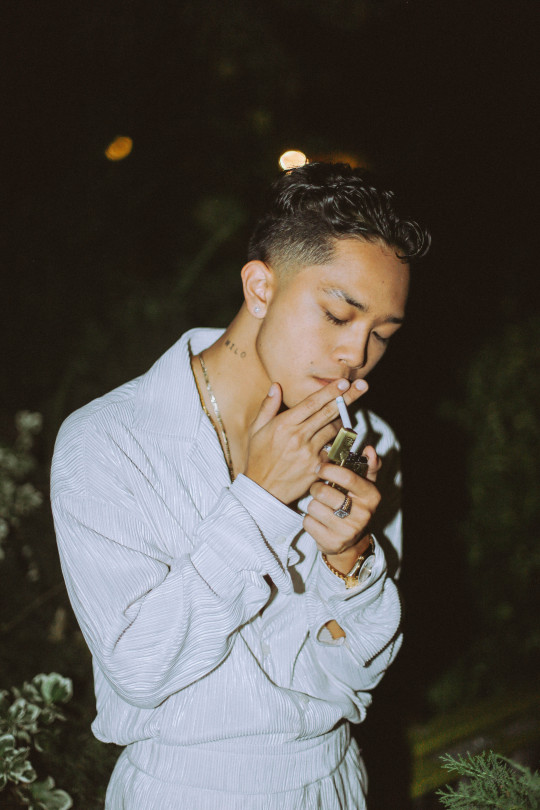
Photo: Frank Lin
The city of Toronto never ceases to amaze us. What can arguably be considered the epicenter for a new wave of hip-hop, Toronto has become notorious for generating underground sensation after sensation. Through their cultivation of hypnotic and innovative soundscapes, to their impeccable flows and lyricism, Toronto has solidified an extensive roster of industry frontrunners, and Nilo Blues is proving to be the newest addition to the team.
Despite being a self-proclaimed poster child for Generation Z, the 21-year-old is anything but ordinary. Growing up in the Toronto art scene, Blues encompasses what it means to be a multi-hyphenate creative, utilizing his talents as a singer, rapper, dancer, and producer to tell stories that grapple with his Asian identity within the context of western society.
His debut single, “No Risk Involved,” is an intrepid statement on Asian cultural identity and showcases how Blues’ struggle to live and create beyond rigid stereotypes has ultimately fueled him to pave his own way, in music and life. His nuanced and complex approach to the modern trap soundscape mirrors that of his own evolution and understanding of his own personal identity. Woven within his uncompromisingly honest storytelling and conviction lies the infectious hooks, melodic arrangements, and unsparing production of a true, multi-hyphenate artist. And despite “No Risk Involved” being the official introduction to his discography, we’re here to tell you that it’s just the tip of the iceberg for Blues.
As we patiently await his debut EP, set to release this summer, Blues gives us a peek at what’s to come with his most recent drop, “Akira Harakiri.” Explosive and audacious, this track has the power to cause havoc to the silencers of a corrupted system. Compiled within roaring trap-laden beats and terse hip-hop rhythms, Blues’ adroit vocals and dynamic fluidity convey a sense of fervor, all while challenging the status quo of Asian representation within American culture.
“Akira Harakiri” pays homage to the anime that Blues grew up with, most notably the raw tenacity of Akira and the thriving energy of Dragonball Z, which influenced its sonic foundation and cinematic execution. In an effort to gain a more comprehensive understanding of his artistry, we spoke with Blues about his position in the current Toronto-trap soundscape and what motivates him to create breakout tracks like “No Risk Involved” and “Akira Harakiri.”
Ones To Watch: It seems like dancing used to be a significant part of your life before music. What sparked your transition?
Nilo Blues: Growing up I was surrounded by music, whether it be at home or in the dance studio. I always had this natural appreciation for music grow in me because of all the different sounds I was surrounded by. I remember having 10-hour dance rehearsal days and then coming home to record photo booth videos of me and my best friend spitting melodies and lyrics over beats we found. I started producing at 16 when I discovered the iMaschine app for iPhone. I would spend hours trying to cook up beats until one day I decided to learn Ableton Live. My mentor cracked it on my laptop and started showing me the ropes, instantly I was hooked. My musical journey honestly started out from me just wanting to make music I could dance to. I owe a lot of myself to dance. 100%.
Has being a dancer influenced your creative process at all?
Dance has influenced me creatively in many different aspects of the process. Growing up as a dancer, you immediately instill a high level of discipline and work ethic as a young child. We were training like athletes and expressing like actors. It shaped the way I hear music (especially my own), it developed my approach on execution and staying on my P’s and Q’s, and it allows me to perform and add a visual component to the sonics. I grew up admiring Michael Jackson, James Brown, JT, Usher and now Bruno Mars. They all hold all aspects of their art to such a high standard. I’m trying to set that exact same standard and quality, through my own vernacular.
Growing up in what can be considered as the epicenter of Canadian hip-hop, do you think Toronto, and the artists that have put it on the map, have influenced your sound at all?
I started learning how to make music right when the 2015-2016 Toronto rap boom happened, so definitely. I feel like Toronto artists collectively do such an amazing job at emulating the vibe of Toronto. At a time where Toronto was only synonymous with Drake (the GOAT), The Weeknd, and PND, Toronto artists really stepped up to the plate and let the world hear the type of shit we’re on. It's super inspiring, and I just want to keep pushing the envelope. I’m trying to land where no one has before, and make my mark in everything I set my mind to. I’m hungry and I want to get great shit done. I thank Toronto and the lively music scene in the city for sparking that.
Your first single “No Risk Involved” highlights the misrepresentation of Asian identity in mainstream culture. Why was it so important for you to create your own narrative and debunk westernized versions of Asian culture and identity?
My family was the main inspiration for wanting to evoke that conversation. Western media loves to exploit the great ideas from different cultures without ever giving credit to the cultures that cultivated them to begin with. They perpetuate false narratives and generalize us in order to keep control. I’ve seen what my family has gone through in order to even be here. My mom is Filipino, and my dad is Viet-Chin, so I’ve had my fair share of perspectives at a young age. One thing I can guarantee is that Asians aren’t as one-dimensional as the media portrays us to be. It’s about genuinely telling our stories, and being able to control the narrative in the world we share with the culture.
How was it filming the “No Risk Involved” video? Did you have a vision for how you wanted it to look?
It was amazing. I definitely felt back in my element while performing on-screen. The positive energy and hard work by everyone on set was the difference-maker. I feel like that energy shines through the video. I’m so grateful to have had such an amazing cast and crew, they fucking killed it. As for the concept, NRI was one of the very first concepts I started developing with my team. Had my first meeting with Angelica Milash, the director of the video, and everything clicked. The inspiration was drawn from aesthetics you’d see in legendary Hong Kong movies like Young & Dangerous. We also based the female looks on different characters from movies that included Asian characters with exaggerated Asian female stereotypes.
youtube
You once tweeted “I love good music but when an artist can pull off a great visual it tells you a lot about that artist.” Do you think it’s important for artists to be active creative directors in the videos they come out with?
Personally, I love dipping my fingers in every pot when it comes to my creative direction. I believe it takes a strong team in order to create beautiful shit, and, as the artist, I want to lead the team to victory. If one of us wins, we all win. Being active as a leader is what’s important. Sharing ideas, and building with the people around you. That’s how the best ideas shine through. You just gotta be a leader with this shit. Take control of your vision and work together to execute. If you aren’t paying attention to every aspect of your craft, you’re only going to see one perspective. At the end of the day, no one will execute your own ideas better than yourself. We all have that capability.
Your newest single “Akira Harakiri” is inspired by the 1988 cult cyberpunk film Akira. How did this iconic anime influence your lyrical and production process?
I wanted the essence of the track to emulate the same essence of the movie. The production was what sparked the idea. Colin Munroe was working on the beat while we bounced ideas around and I instantly felt the beat belonged in an anime. Akira was an automatic click. This song is supposed to feel like a song The Capsules gang would bump around Neo-Tokyo. I loved the dynamic between Kaneda and Tetsuo in the film, and wanted to combine the charisma and poise of Kaneda with the maniacal energy of Tetsuo. That’s also something I want to tap into on the visual component as well. This song is an homage to a visual masterpiece, as well as an iconic moment in film and culture.
What are some of your favorite anime films?
I grew up watching anime on TV like Dragonball Z, Yu-Gi-Oh!, Pokémon, Digimon. As I grew older, I wasn’t exposed to as much as before, but I rediscovered my love for it in high school when I binge-watched Death Note twice in succession. Now I’m trying to watch as much as possible. I feel like I have so much to catch up on lol.
What are some of your goals for 2020? Both as an artist and as a human being?
I want to work on killing the urge of having a cigarette or vaping again. I quit at the end of 2019, and started working out four times a day with my trainer. I’m trying to stay consistent in doing my laundry but that shit fucking sucks. I'm trying to meditate more, as I’ve recently picked up on transcendental meditation and want to keep consistent. Other than that I wanna keep dropping cool shit and repping what I know best. I wanna keep pushing myself to my limits and keep evolving. I hope people find strength in my music and I want to evoke new thought and conversation.
What can we expect to hear more of in your future projects?
More genuine energy. You’ll definitely be able to feel exactly how I felt when creating the music, from the growing pains to the gratitude. More singing too. You’ll be able to identify the spectrum of my sound, and how dynamic it is.
Who are your Ones to Watch?
I’ve been on my hip-hop shit as of late, so I’ve been bumping a lot of Kaash Paige, Fivio Foreign, The Kid LAROI and shit. Deb Never is an artist that I've been wanting to work with personally. Out of Toronto, definitely keep your eye out for Stefani Kimber. One of the most talented artists I’ve ever heard and a great human being. She’s definitely one of my top Ones to Watch artists.
youtube
2 notes
·
View notes
Text
The Most Affecting Films of 2017
I love putting this list together because a.) I’m a film geek and own it, b.) this writing exercise is cheaper than therapy, and c.) it helps me discover previously unrecognized themes shared across my selections. The thread of history runs through these picks, that of nations as well as the complex and messy relationships between parents and children. History is parent to our present, and thus the thematic through line of my favorite movies of 2017. Each title brought me to tears or rented space in my mind for days after the initial viewing, often both, but earned this response through quality of storytelling.
Choosing my top ten was difficult (see the following “Runners Up List” for evidence) because 2017 was a fine year in film. We should celebrate cinema, and the opportunity to do so, as long as it remains this dynamic.
-Matt
Honorable Mention: Their Finest

Directed by Lone Scherfig
Written by Gaby Chappe and Lissa Evans
A movie celebrating storytelling and writing, chronicling the making of a movie about the Dunkirk rescue, set in England during the Blitz, addressing the role women played in the war effort, packed with an embarrassment of Britain’s best character actors, exploring how cinema’s escape can help heal us in times of crisis, and that is also a love story has no right to work. Scherfig’s film defies such limitations and hops between these aspects like a trapeze artist. It’s a crowd-pleaser, a heartbreaker, and a movie celebrating movies, all buoyed by Gemma Arterton in the lead.
10. The Lost City of Z
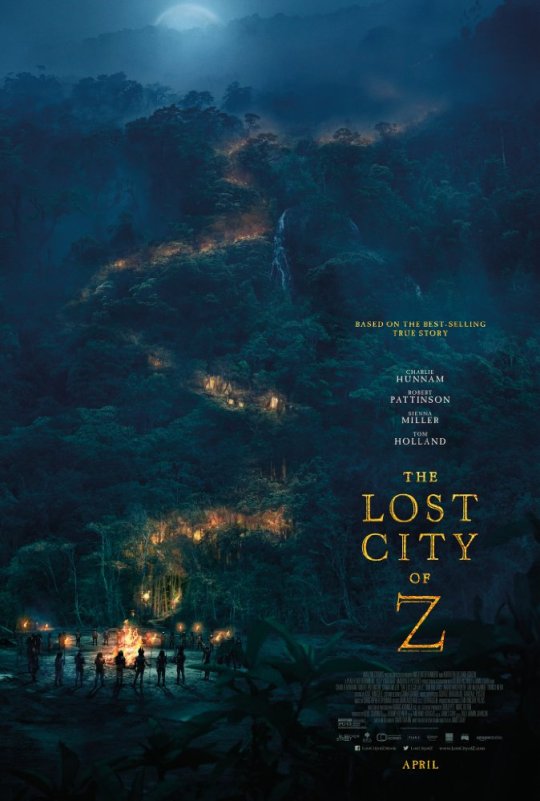
Written and Directed by James Gray
Cinematography by Darius Khondji
The real Percy Fawcett’s 1925 disappearance in the Brazilian jungle provides an unanswerable question that hangs over Gray’s film as he endeavors to explore mysteries of the egocentric self through immersion in the natural world. Like the protagonist, this seems simultaneously paradoxical and fitting.
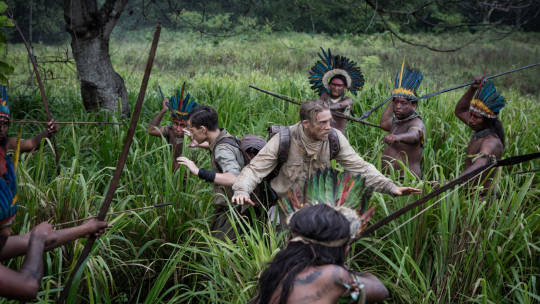
Some clever non-linear editing and a final shot of Nina Fawcett, the only actual hero here, walking into the reflected image of a jungle, make for a lingering metaphor on those understandings our hearts are granted, and those we can never attain.
9. Toni Erdmann*
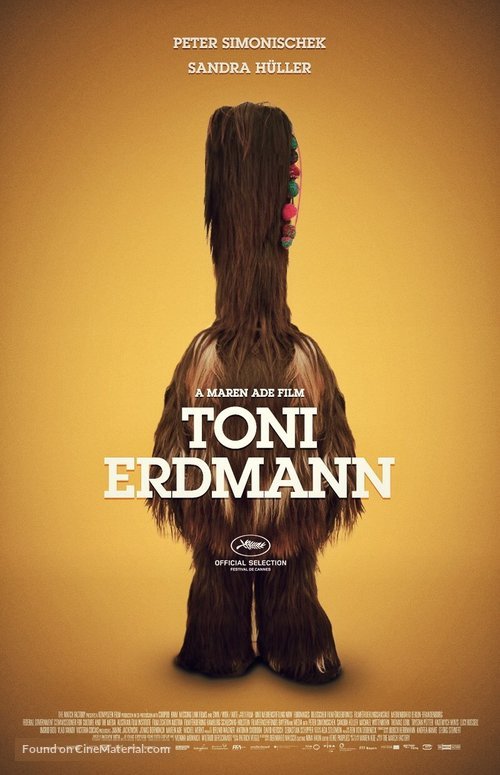
Written and Directed by Maren Arden
When I thought this dark European comedy couldn’t get more surreal or funny, it didn’t, but instead ends with a peerless final beat, then drops The Cure’s “Plainsong” over the credits.
Cut to me radiant with joy at what cinema makes possible.
Hollywood stories of parents and children aren’t ever this delightfully weird, or dappled with scenes that let us find our own insights about economic disparity, sexism, and capitalism’s darker outcomes. Hollywood stories aren’t ever this genuine.
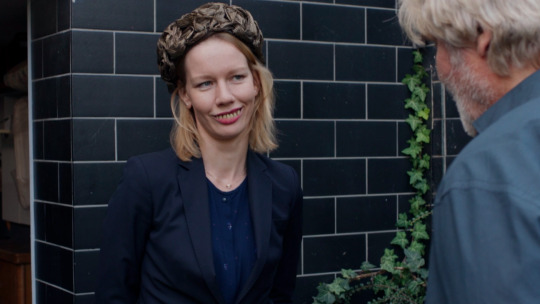
Maren Arden proves herself a visionary, not just among up-and-coming female directors, but all directors, and since her open-ended final scene is perfection, I’ll let the last dialogue in her script finish the same way:
The problem is, [life is] so often about getting things done. And then you still have to do this, or that. And, in the meantime, life just passes by. But how are we supposed to hang on to moments?
* released in 2016 but I had no way to see it until 2017
8. The Big Sick

Directed by Michael Showalter
Written by Emily V. Gordon & Kumail Nanjiani
Gordon and Nanjiani’s story (based on the origin of their own marriage) took me two viewings across two seasons to relent and finally love it. Now it has my whole heart thanks to an earned emotional response and a script respecting the perspectives of all its characters. Likely the best screenplay of the year that might not be recognized as such, stand up comedy and parents are rarely revealed onscreen with such nuance, and never before in the same film.
7. Five Came Back
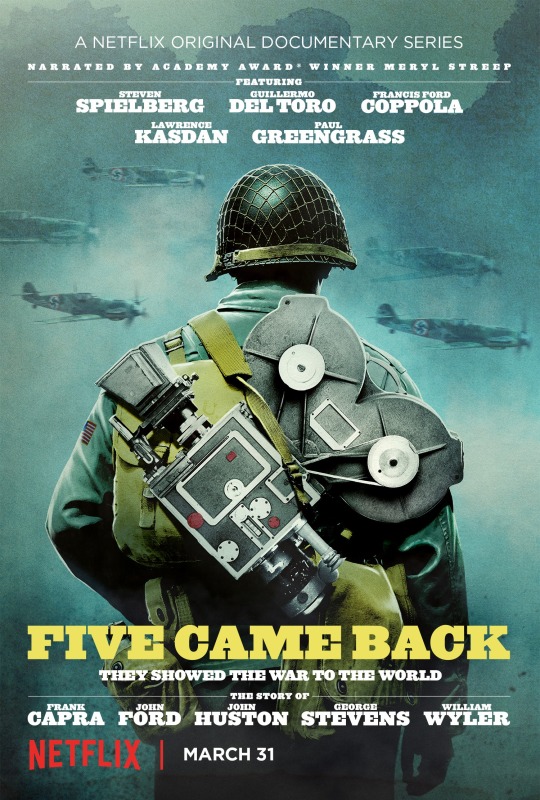
Written by Mark Harris (based on his book Five Came Back: A Story of Hollywood and the Second World War)
Directed by Laurent Bouzereau
This three-part Netflix documentary chronicles the contributions from five of the top directors in Hollywood during WWII, many of whom gave up lucrative careers to serve the war effort via their craft. We see how filmmaking and storytelling, as the translation of fact and occurrence through moving image, can be a weapon and should be used with care. The stories of these five directors and how their lives and art were impacted by the conflict is engagingly humane. And the talking heads (aka legendary current filmmakers) are so damn insightful. MVP being Guillermo Del Toro.
We celebrate such humanity, and in it our own, flawed and beautiful as both might be. This is best captured in Capra’s final voiceover proposing hope where it is needed.
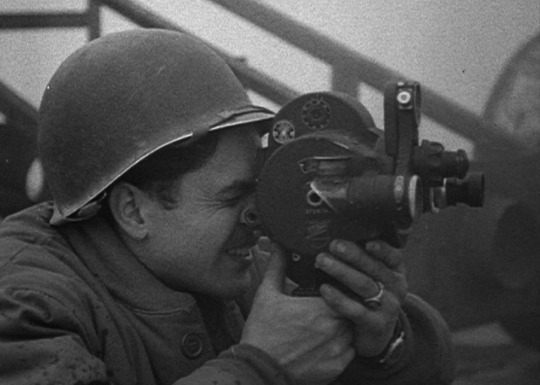
6. Wind River

Written and Directed by Taylor Sheridan
Sheridan’s crime-as-myth story is most concerned with grief and the ways we numb ourselves to pain at the cost of the memories of loved ones lost. Winter and the West stand in a neo-western backdrop where he colors the idea of how struggle can hollow out even the strongest among us.
We get our genre kicks in the Mexican Standoff shootout (praise to the screenplay-rulebook shredding use of editing and a flashback to set up this reckoning). The patience in ending his film with not one but two conversation scenes shows a preference for empathy over spectacle, and the way the injured souls connect therein haunts me.

5. Three Billboards outside Ebbing, Missouri
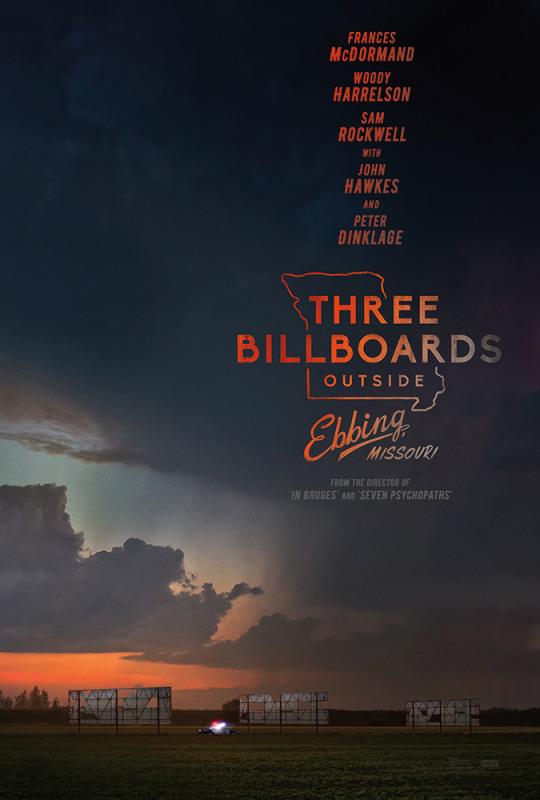
Written and Directed by Martin McDonagh
I enjoy being challenged by a film. McDonagh’s picture beat the shit out of me then tossed me a lollipop, and I beamed like a lovestruck idiot. An early reference to “A Good Man is Hard to Find” alludes that that there will be no predominant tone to cling to but instead a vacillation of many throughout this winding trip into darkness where any good that exists is a miracle. In the final scene and sublime character change of Sam Rockwell’s Officer Dixon, it does.
4. Blade Runner 2049
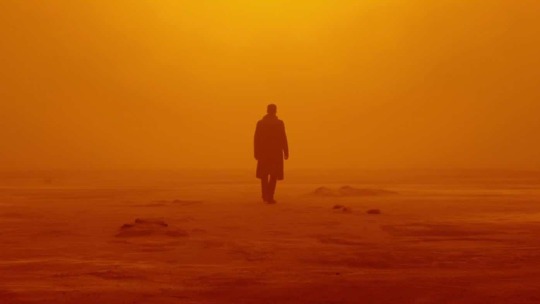
Directed by Denis Villeneuve
Cinematography by Roger Deakins
There wasn’t a more thoughtful film this year than Deakins’ visual magnum opus. The intelligence expected of Villeneuve surfaces throughout in beautifully complex questions about life, witnessing, and how we achieve our sense of identity.
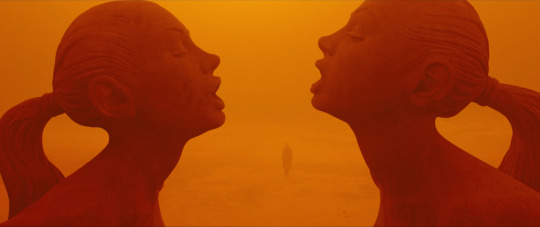
The choice of Gosling’s K / Joe as protagonist, his illusory sense of importance as the “one” and what is done with this concept, shows how important it is to value the willingness to make choices, even when they seem tiny and tossed into the void. In Joi, he may have found a facsimile of love, or he may have actually found it. In response, we question our right to declare another’s life or love “artificial”. The Hero’s Journey archetype is so common that it’s almost instinctive. Villeneuve subverts these expectations by stripping heroic action to its purest and leaving us with K / Joe’s not-tears in the ashen snow.
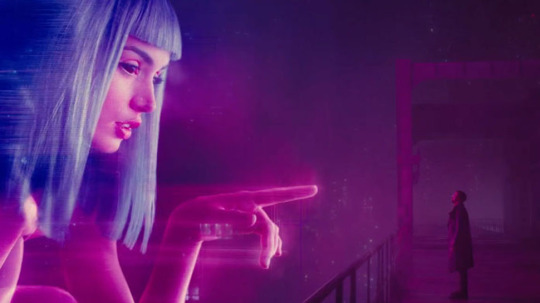
The acting is typically strong because, while he isn’t noticed for it, Villeneuve always gets strong work from his actors. Through one of Harrison Ford’s best performances, the theme of parents, children, and sacrifices made just for the latter’s prospect of a better life is most poignantly rendered in one line: “Sometimes to love someone, you got to be a stranger.” As 2017’s best sympathetic villain, Luv doesn’t possess the freedom of her inferior replicants; she is bound to Wallace, a slave in her programming. Wanting to be special, to be the “best one”. This denied want and inability to make her own choices, to create life and be alive, warp her into a destructive force seeking to stomp out anything that reminds her of her chains. Leto’s megalomaniac Wallace is a god-aspiring big bad in the Greek chorus role, showing up to voice the film’s themes but in a way that avoids ponderousness.
I could write an essay on this film. (Note to self: write more essays on films.)
3. Lady Bird
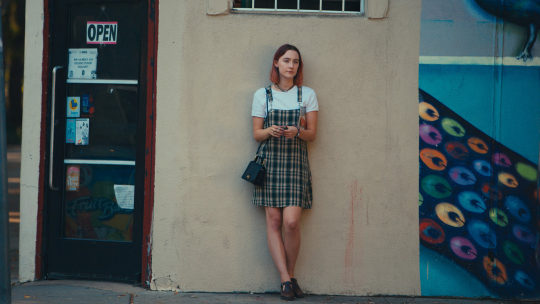
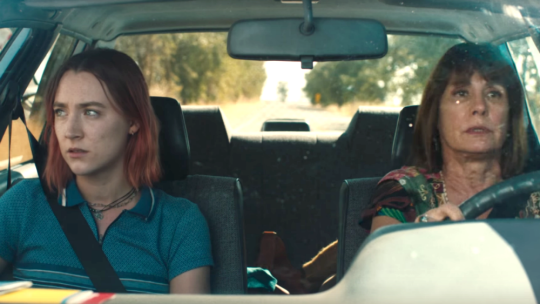
Written and Directed by Greta Gerwig
Gerwig’s work is so accomplished that my mind boggles when contextualizing it as her first directed film. The movie world exists here as specific enough to leap outside of time and place in that mysterious dynamic of singular-becoming-universal. Coming of age stories with comedy draped around them, or them around it, are usually judgemental of broad supporting characters who get portrayed in one shade only. This film is so balanced and sympathetic to its people, and I say “people” with intention, that we turn from cursing them to pitying to loving as fluidly as we do from laughing to choking up. The final sequence might be the year’s most affecting editing through a use of different characters in essentially the same shot, and shows that car chases have nothing on cross-cutting between drivers in the Sacramento magic hour.
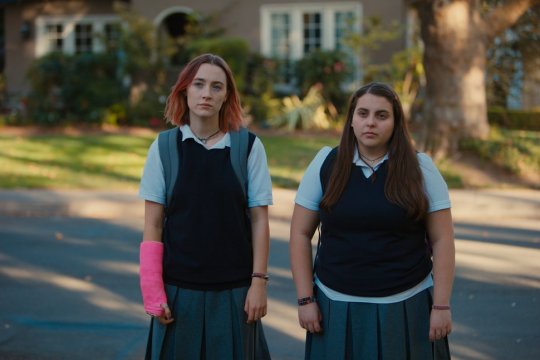
2. Columbus
Written and Directed by Kogonada
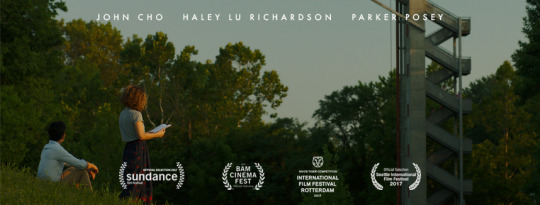
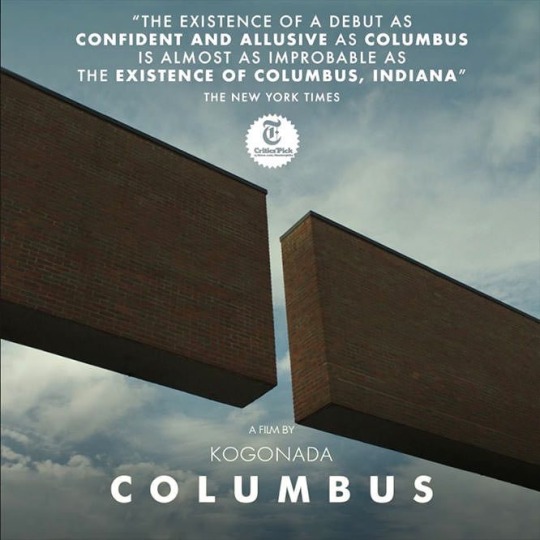
Sheila O’Malley in her Rogerebert.com review:
"Columbus" is a movie about the experience of looking, the interior space that opens up when you devote yourself to looking at something, receptive to the messages it might have for you. Movies (the best ones anyway) are the same way. Looking at something in a concentrated way requires a mind-shift. Sometimes it takes time for the work to even reach you, since there's so much mental ballast in the way. The best directors point to things, saying, in essence: "Look." I haven't been able to get "Columbus" out of my mind.
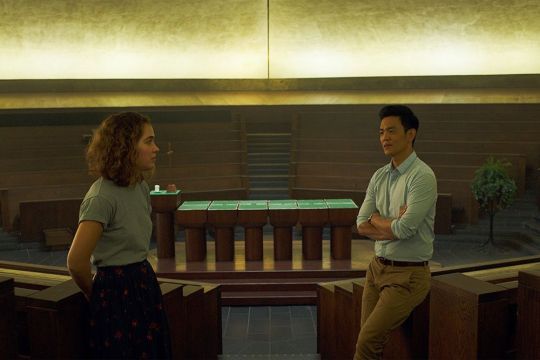
Wholeheartedly agreed. It clung to me. First time director Kogonada gives us an immaculate use of the frame and mise en scene. My eyes wanted desperately to eat the screen, each and every frame a morsel. And my entire being wanted to remain in the film’s world. Sadness and all.
Kogonada’s work isn’t all visual gloss but uses stillness and subdued conversations to belie an emotional tempest inside each of the two characters. This is a romance, but one just as in thrall with life as it is with clean modernist lines and the creation of form through negative space that here symbolizes those unknowable aspects of Jin and Casey (Haley Lu Richardson lights the screen in my favorite performance this year), and by extension those they love. We carry our parents with us just as these buildings carry their histories. Columbus’ characters need to navigate the empty spaces in and around themselves to connect, even if fleetingly.
1. Dunkirk
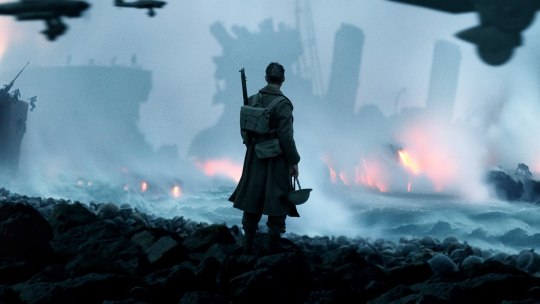
Written and Directed by Christopher Nolan
Cinematography by Hoyte Van Hoytema
Score by Hans Zimmer
I can rightfully be called a Christopher Nolan fanboy, but there’s no arguing the viscerality of this experiment. Nolan, Hoyte Van Hoytema, Hans Zimmer, and the rest of their collaborators crafted a singular war film that really isn’t a war film. It’s a story more existential. Time is elided, shattered, and edited with an exactitude that comments on history unlike any other movie in this genre.
That audiences responded to a story asking them to participate, emotionally and physically, but learn little of its characters is also fitting for the theme of people choosing to risk their own well being for the betterment of others. The lesson is to put aside your wants and let an experience take you.
The propulsive score, like the tension, never relents. How such induced anxiety can be thrilling is for later study (and this film will be studied for decades hence). It’s the notion, however, that I can be brought to tears by the shot of a Spitfire coasting across sky, out of gas but not fight, by small boats dotting the sea that are referred to as “Home”, and by Mark Rylance simply nodding to his son in acknowledgement that the right thing to do is often an act of empathy running against our in-the-moment emotional surge, that belies an elegance words can represent, but only sound and image can actually invite you to feel.
_______________________________________________________________________
We are born into a box of space and time. We are who and when and what we are and we're going to be that person until we die. But if we remain only that person, we will never grow and we will never change and things will never get better.
Movies are the most powerful empathy machine in all the arts. When I go to a great movie I can live somebody else's life for a while. I can walk in somebody else's shoes. I can see what it feels like to be a member of a different gender, a different race, a different economic class, to live in a different time, to have a different belief.
This is a freeing influence on me. It gives me a broader mind. It helps me to join my family of men and women on this planet. It helps me to identify with them, so I'm not just stuck being myself, day after day.
The great movies enlarge us, they civilize us, they make us more decent people.
-Roger Ebert
_______________________________________________________________________
Promising 2017 releases that I haven’t seen yet and might vie for retroactive inclusion on either this or the “Runners Up” list:
Star Wars: The Last Jedi
The Disaster Artist
Darkest Hour
Mudbound
First They Killed My Father
Spielberg
The Post
Molly’s Game
Phantom Thread
The Shape of Water

1 note
·
View note
Text
mother! A Dark Allegory Sacralizing the Relationship Between Religion and Secularism
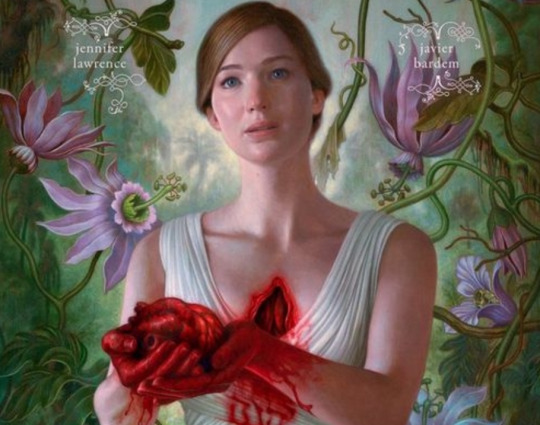
My vitals are oatmeal, my brain is slain, my soul is recovering from the syringe-injected wtf emotion. I haven’t been this excited since Aronofsky’s last release, NOAH (2014). And BLACK SWAN (2010) before that. And THE WRESTLER (2008) before that. And…you get the point. I’ve been team Aronofsky from the beginning (Sundance 1998, where he debuted PI). And, like all of his films, I’m destroyed in the most cathartic way as the credits roll. I’m reveling in the darkness of this feeling, this theater, paralyzed with intense awe. I have strong hope there’s light dancing somewhere inside my marred head, guiding me through the fiery, hellbent tunnels of what I just experienced. And MOTHER! is an experience!
What an absolutely sickening, messed up, brilliant cinematic masterpiece!!!!
Here is a film that only Aronofsky could’ve made, a film that contains a motherlode of rich interpretations, a symbolic maelstrom of ideas needing to be painfully birthed. The imagery stains, the ideas baffle, the third act impossible to predict, stomach, or prepare for. Believe me when I tell you: The barbs are real. And it makes for an ultra provocative kind of art because it’s so vulnerable, so sprawling, relevant and contentious in its reach. I might even describe it as a scalpel-sharp metaphor that rips, grinds, and eviscerates every faction of humanity ever to exist. No one is safe. Everyone is indicted. And Aronofsky, like the God of Genesis, is pissed with everyone, pissed with creation, pissed with politics and religion, with the overall state of the world, and he’s ready to burn it all down and start anew.
It’s a film that kind of plays out like NOAH — its prequel and sequel—but replaces the watery deluge with apocalyptic fire. It uses a biblical framework to shape and express a lot of political and humanitarian turmoil, and wraps them all together into one grand, outrageous, cyclical metaphor that might be difficult to grasp without a solid backing in these subjects.
MOTHER! isn’t a political or religious film per se as it is a human film commenting on the state of the world and how we endlessly abuse it. It evokes political and religious overtones to the extent of retelling the creation myth from a gnostic, secularized perspective. It’s also about a lot of other things — the social dynamics between artist, muse and feasting fandom, the creation of art itself, the downfall of civilization, of ecosystems, of human safety, the obsession with social media, tabloids and selfies, the portrait of a decaying marriage, the dangers of open-mindedness, and the list goes on. The interpretations will be myriad.
I found its retelling of the creation myth, however, one of the most moving, cross-pollinating attempts to ever sacralize the warring relationship between religion and secularism.
That retelling might go something like this:
The Earth — our world — is feminized, a Mother to all, a source of both nourishment for humanity and victim of male aggression.
Man’s aggression spawns from greed — from His dominion over Her (the Earth) — thereby becoming a catalyst for His belief in His dominion over Woman.
And so as the Earth is mastered, conquered, penetrated, plowed, tilled, burned, subdued, inhabited, and controlled, so is Woman.
Her paradisiacal garden is turned to waste, but Man continues to plant and labor and sow, and by brute sweat makes Woman yield — conceive.
The Earth — the Mother of all — “gives and gives and gives,” and in return gets invaded, pillaged, and raped, rebirthing the vicious cycle.
And Mother bears it, endures it, braves it, serves it, puts up with it.
Cruel male pagan gods divine this link between Mother and Earth, they gaslight it, and allow for the problem of evil to run amok for the sake of artistic musing and divine retribution for sin.
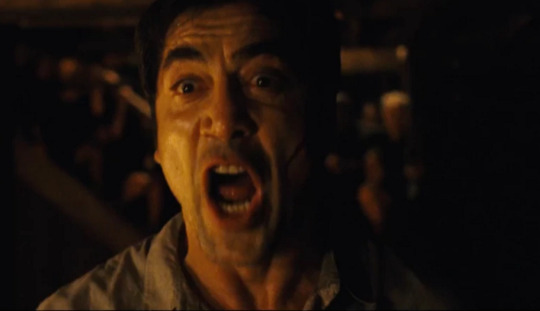
We’ve seen Aronofsky’s pagan sensibility shine before in BLACK SWAN, where anything that manifests itself to you may be a god, but in MOTHER! this paganism pulses and groans under the weight of what I found were five highly potent, timeless, relevant-in-2017 themes:
1) Mother, as an earthen vessel, holds the seeds to every noxious, selfish, unbending human crime within Her.
2). Mother, as an earthen vessel, may be pillaged, raped, and controlled by Man through “divine” rights, even corporation rights, unleashing the revelations and purgatories within Her.
3) Mother, as an earthen vessel, births, feeds, rears, nourishes, and puts up with a lot of vile, inane, intruding human garbage.
4) Yet Mother, even as this earthen vessel, can reach a furious, volcanic melting point, a chamber that can no longer contain the scalding pressure inside, exclaiming:
(!) “Enough!” (!) “No More!” (!) “The End!” (!)
5) Yes Mother! now as embodied, apocalyptic fury, can reject crude male taming and savagely roar back and boil over with destructive, unmatched chaos.
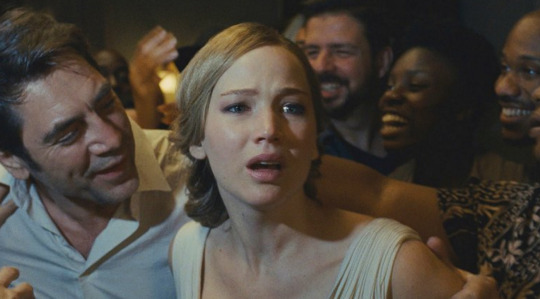
These themes stretch towards the sacred and the profane equally, finding home within the religious and irreligious alike. It’s a brand of home invasion horror that’s critical now. A story about our world bellyaching, roaring, reaching critical melting point — now! And what’s fascinating here is how Aronofsky transfers his past auteur portraits of hysteria and madness (think PI, BLACK SWAN, NOAH) over from his characters now suddenly to the lap of his audience. This will hit very close to home, and many will feel uncomfortable. In fact, the film almost plays out like Aronofsky’s middle finger to humanity at large, a venting frustration at how we mistreat each other and abuse our sacred, mother planet.
The result? Piqued reactions, confused reactions, zero neutrality, shifting accountability, and above all, a puzzle to be ciphered and querulously debated for years to come. This is the BEST kind of art. The kind that divides yet hopefully unites. It certainly is one of the most moving, thought-provoking films I’ve ever seen, one that hits personally close to home. I say this especially as a devout theist who leans on the side of a culturally religious agnosticism.
While this experience won’t be for everyone, I’d argue there’s a moral blade to the film that cuts DEEP, DEEP, DEEP into a problem that everyone is complicit in, right and left, black and white, male and female, me and you, but it isn’t necessarily preachy or scorning in presentation. Ok, it’s seriously messed up. But I reject any reading that claims Aronofsky is a misogynist or without compassion — especially for Jennifer Lawrence’s character — in part because this posture entirely misses the point by disguising a surface criticism as one that ignores the film’s larger, looming global symbolism, and the mighty realities for which those symbols stand.
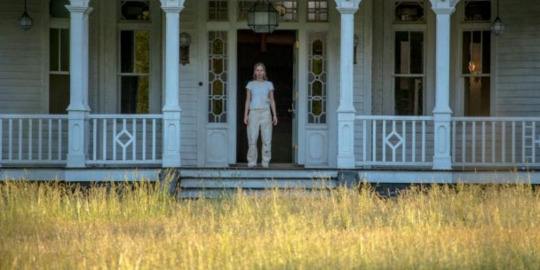
MOTHER! might be the kind of art that liberals love to hate because some are unable to fathom how bad things being depicted is not equivalent to bad things being endorsed, but merely commented, mourned and reflected on. You need look no further for evidence of this than when Javier Bardem stated in an interview with USA Today, “Darren is the opposite of my character…He’s more into Jennifer’s character than my character. When I met him, I was like, ‘Where is this darkness coming from?’ Because he is the opposite of that. He’s nice, caring, generous, funny, very creative.”
MOTHER! has a moral edge to the extent that it forgoes pleasure, or punishes it wherever it occurs, to deliver a higher message. And my reaction to the film was one of total compassion, like a surgeon cutting into rotten tissue to find what parts are still salvageable. Put differently, Aronofsky plunges DEEP, DEEP, DEEP into darkness in order to find what shards of light may be hiding there, a skill he has always excelled at. His canon of work has proven how repeatedly and exceptionally acrid his ability is to peer into the abyss to yield enlightenment. And to make great art you have to go to the darkest place, the forbidden place. MOTHER! raises this cost as an insanely moving, nuanced presentation of what happens when you stare into the abyss — the forbidden place — too long.
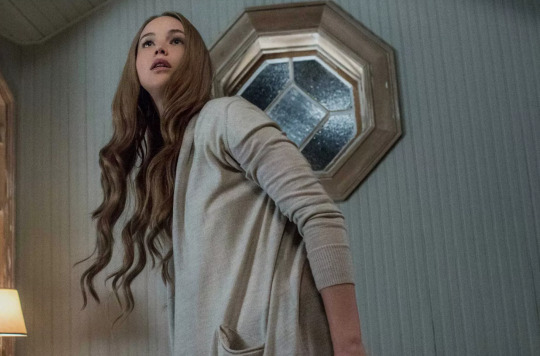
If REQUIEM FOR A DREAM is Aronofsky’s required viewing for D.A.R.E programs, MOTHER! is his required viewing for earth stewards and married couples. If NOAH is Aronofsky’s biblical making of Genesis, MOTHER! most certainly unleashes his apocalyptic, unmaking, hellfire vision of Revelation. If PI is Aronofsky getting into the confined, mentally ill space of his characters, MOTHER! is him flipping that headspace burden over to his audience. If BLACK SWAN is Aronofsky doing hysteria-horror, MOTHER! is him making BLACK SWAN wishing it were difficult material for Sunday School. If THE FOUNTAIN is Aronofsky’s metaphysical view of history, MOTHER! is him exclaiming there won’t be any history left if our course goes unaltered.
And Aronofsky was right: No matter how many trailers/snippits I read prior to watching, NOTHING could prepare me for this sacred, unholy event. NOTHING! And don’t worry, my take here won’t spoil the madness you, too, will be put through (assuming you dare to step inside his theater!). And the third act. Good sweet mother Mary of all things blessed and disturbing, the third act! Good hell. Can’t wait to follow #mothermovie on that one. In sum, I’ve never seen anything like this. Will never be the same again. And will never answer a door knock again. Thanks a lot Darren.
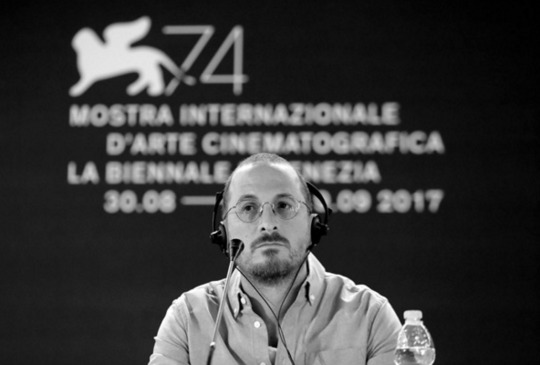
#film#film critique#religion#philosophy#spiritual#politics#divine humanism#film nerd#poetry#darren aronofsky#allegory#bible study
9 notes
·
View notes
Video
youtube
Tangerine (2015) dir. Sean Baker
A Trans Woman of Color Responds to the Trauma of “Tangerine”
Why is it that trans women of color have to experience so much violence to remember that they have each other’s back?
That’s what I got from the movie Tangerine. I enjoyed it. Mya Taylor (who plays Alexandra, one of the two trans leads) and Kitana Kiki Rodriguez (who plays Sin-dee, the other) were fucking brilliant. They were not respectable, they were surviving in the best way they knew how and they were supporting each other even though it was difficult. I loved that they didn’t apologize for their lives or their existence.
Despite this, the audience still laughed at really inappropriate parts, showcasing the way that the film itself fails the story it’s trying to portray. And don’t get me wrong, the story is real. But the way it’s set up, how it’s shot, the progression of the plot — it’s clear that it is offering up the story to a mostly white, bougie audience. It was voyeuristic in the worst possible way. And while the two stars did have a lot of input into the making of the script, white men are still the ones who get the credit. The names of white men are on the script and white men directed the movie. The story was only made real by the beautiful performance of the actors.
One of the things that frustrated me was the way Razmik (an Armenian taxi driver who is a frequent customer of Alexandra and Sin-dee, played by Karren Karagulian) is juxtaposed to that terrible john. Razmik is no better then the dude that tried to rip off Alexandra. But the narrative manipulates you into feeling sorry for him. He is just a poor misunderstood dude who lies to his wife and keeps his desire secret. But he was just as awful as all the other non trans women in the film. He reduces trans women to what we can do for him sexually, fetishizes our bodies and refuses to publicly acknowledge that he desires trans women. He is still exploits them — he just pays well. Whats more, I don’t care at all about men and how they’re impacted by transmisogyny. Because the only reason Razmik and men like him get any kind of grief is because of transmisogyny. But it is not men who bear the brunt of that violence, it is us. Trans women are murdered for the same reasons that men are shamed. So for this film to focus almost half of the narrative on this man and how hard he has it, is very frustrating. Because even in films that are ostensibly about us, we still have to deal with men and their feelings. We still try to center male experiences.
The complicated relationship that these two trans women had with the men/love in their life was hard to watch. These were people who really and truly hated Sin-dee and Alexandra but said that they love them. They manipulate, take advantage of and abuse them. Chester was an awful abusive liar, but what choice does Sin-dee have? When validation and love come, even if it’s twisted and fucked up, you take it because otherwise you are just alone and sometimes the illusion of someone supporting you is better than nothing at all. I saw my experiences with men reflected in theirs and it fucking hurt. Trans women of color aren’t valued — again, we exist only to serve and perform for men. What does it mean that the people that are supposed to value us the most end up abusing us? What does it mean that trans women of color are often the victims of domestic violence but there is no narrative about it. We cannot be victims because we cannot be loved.
The final moment of the film comes after Sin-dee realizes that Alexandra slept with her boyfriend. Sin-dee is upset with Alexandra and tries to go off by herself but Sin-dee is assaulted, called a tranny faggot and gets urine splashed all over her. An intimate moment ensues where Alexandra takes care of Sin-dee and Sin-dee forgives Alexandra. That moment of sisterhood is so real. Nobody is going to look out for trans women of color except other trans women of color. We only matter to others when we are performing for them. But why does the film find it necessary to emphasize this sisterhood by subjecting them both to violence? What does it say about the director and the audience that this was the only way to bring them back together, because they have no other choice because the world is trying to kill them. This scene also shows them taking off their wigs which is just another instance of that trope saying that trans women’s femininity is not real. It’s a fabrication that comes off during intimate moments, cause what’s “real” is what’s on the “inside”. What does it mean that all the character development that occurred in that film was through trauma and violence? What does it mean that we can only see their vulnerability, their strength, their resilience through this moment of degendering?
I’m glad I went to see it. Seeing some of my experiences reflected in that film were really important and some of the ways they handle sex work and relationships is real. I appreciated the nuance in the way that they displayed men and their relationships to trans women. Trans women of color are almost always seen as objects to be controlled, held and exploited. The movie was clear about this. Clear that the ways men relate to trans women is toxic and fraught with dynamics of power that are abusive. Chester (Sin-dee’s boyfriend and pimp, played by James Ransone) was terrible to Sin-dee and he manipulated his way back into her good graces. Razmik was only interested in how these women could serve his pleasure. Both models — both through intimate relationship and client — capture the way that men are terrible to trans women time and again.
I also liked the way that Sin-dee was in control of her interaction with Dinah (the white, cis woman and sex worker who Chester cheats on Sin-dee with, played by Mickey O’Hagan). So often, cis white women will invalidate our womanhood. They will exclude us from women’s spaces and be generally awful to us. Transmisogyny is pervasive and cis white women are not exempt from perpetuating that. It was satisfying to see another trans woman of color in control of her interaction with someone who was actively denying her womanhood, who mocks Sin-dee’s desire to be valued and seen by her partner. It was satisfying to see her take what she needed from her when so often trans women of color are denied. White feminists might be inclined to read what Sin-dee does as violence against women but Sin-dee is not in a position of power over Dinah. And it was satisfying to watch. And while I do not trust the intentions of the white male director who shot that scene (because he would be perpetrating that violence), I do appreciate the moment for the satisfaction it gave me.
Even with these positive experiences, the voyeurism and almost lurid lens that the film was shot in makes it so that it only serves the consumption of cis white people. I cannot separate or ignore the fact that this was a film made by white men. And how these white men’s careers are going to profit from this film while the actress’s careers will most likely languish.
And why is it that so few TWOC (aside from Laverne Cox and Janet Mock) get any kind of airtime when it doesn’t involve trauma? Why are cis folks only interested in seeing us hurt, traumatized and alone? Those select few trans women who do get the spotlight, not just when they are murdered, are the exception and often tokenized by the spaces that they are in. You only ever hear about TWOC after we have been murdered. And in many ways this film is no different. It relies on the difficulty of our lives, it’s fetishizes the way our existence is marked by this world in order to titillate, to entice. The exotic other enchanting the “normal” cis white audience. And they leave the theater thinking that they know something, that they are more familiar with the lives of trans women. But our lives are not like in the movies.
After the last shot and the credits started rolling, I just broke down and cried. All that trauma and pain laid out like that so that people who don’t give a fuck about us, who just want to eat us alive — it was too much. It was so much to be in that audience, hearing their laughter and knowing we are just some fucking joke to them. That the things we face are a fantasy playground they can hang out in and then leave. That our lives only have meaning through the trauma experience. And don’t get me wrong, our trauma is real. But trauma isn’t the only thing about my existence that is real. But it’s the only thing cis folks care to see. Because a trans woman happy and loved is just so fucking weird to be real. Because seeing the full breadth of our lives is too much for people to handle. And because white people cannot help but exploit our lives.
In many ways, this film is similar to Paris is Burning. Brilliant and important and life saving while at the same time exploitative to the actors/subjects. The reviews of this film go on and on about Sean Baker and how he shot this film on a iPhone but where are the interviews asking how Mya Taylor felt shooting this film? Where are all the accolades for Kitana Kiki Rodriguez and her beautiful nuanced performance? Jennie Livingston made out like a bandit from that film and so will Sean Baker from this one. And the system is set up that only a white person could even get the funding for this project. TWOC doing this for ourselves doesn’t get the same level of attention or money. When will we get our coins? When will the work we do, the art we make, the lives we lead be for us, by us? When will white cis people stop exploiting our bodies for their profit?
https://www.autostraddle.com/a-trans-woman-of-color-responds-to-the-trauma-of-tangerine-301607/
0 notes
Text
2018 Favorite Movies
It’s been a while since I’ve made one of these lists. This year was filled with great foreign films and documentaries, as (spoiler alert) you will see many of below. As always, I have not seen every movie of the year, but I think I have gotten better over the years at understanding what kinds of movies I would find interesting, and what directors I will always look out for, so in that regard, I think I have been as exhaustive as I can to make this list.
Honorable Mentions:
The Ballad of Buster Scruggs: I’ll watch anything the Coen’s do, and if history suggests anything, I’ll probably like it. This is one of the most unique formats I’ve seen a Coen film (anthology), but I’m glad I got to see their take on this film format, because I do enjoy films like this (Paris, Je’Taime, and Wild Tales are two of my favorites). This film did a good job of keeping with the overall western theme they were going for, even if some of the stories were more engaging than others. The timings were a little uneven as well, as some stories were (and felt) longer than others, which kind of threw off the pacing and rhythm of the film. If I know the Coen’s though, they might not be done exploring the genre of the Old Western.
Green Book: One of the more “meh” best picture winners of the past several years, maybe since The Artist. Viggo Mortenson did a great job and the chemistry between him and Mahershala Ali felt authentic, but I wish there wasn’t so much cheese spread across the film. I wish I could have a caution sign that pops up in front of a director’s eyes before they shoot a scene, reading: “Does this scene require this much drama (cheese) to effectively move the plot or build upon the character(s) in an appropriate manner? If it is not a resounding YES, please RECONSIDER altering the scene to be more authentic!!” I’m rambling and may be piling on this movie for the shortcomings of a lot of Oscar “bait,” but I (and many others) see it every year and every instance of it gets more and more frustrating.
They Shall Not Grow Old: War documentaries are nothing new, but I was thoroughly impressed by this take on the documentary format by Peter Jackson. I highly recommend sticking around to the very end of the film (after the credits) to see a mini-documentary on how they made the film and their thinking behind the structure, layout, and overall design of the film. The amount of work they put into the project is even more apparent after seeing that, and it just underscores the grand scale a world war was.
Minding The Gap: This documentary does a great job of utilizing time to its advantage. I’m not talking about run time or pace, but rather telling a fluid story about several people over a period of several years. It felt very natural and allowed you to take a journey with these people and understand their story even more. It’s a documentary that is easy to empathize with, not just for the struggles the characters deal with but more so the journey the film takes us through, and how we can relate to the themes of childhood, family, community, friends, dreams, escapes, our future, mortality, and many other heady themes.
Cold War: There’s a lot to unravel when watching this movie, from the shot compositions, to the juxtaposition of the music, to the journey of the relationship between Wiktor and Zula. I love the way music is used as a storytelling device, and the beauty of the minimalist style of music plays perfectly with the beautiful cinematography (black and white never looked so colorful). A lot was done well, but the pacing and the ending kept it from being an even better film.
10. Burning

I admit I needed to be aided in terms of figuring out what all happened in this film exactly. But once I started delving into what other people had to say about the film, I think that’s exactly what was supposed to happen. I love how even as slow prodding of a film this is, it still manages to simultaneously leave time for you to think and not at the same time. For as many times as I felt like I was going to fall asleep, I still feel like the pacing of this film was done as best as it could have been. This is a film where ambiguity is the end goal, and that’s perfectly ok, especially with how the film is laid out and shot.
9. Eighth Grade

The passage of time is never kind to us. Even with the most positive outlook on life, and a happy childhood or upbringing, there is just something about reflecting on a period of time in your life (i.e. nostalgia) that brings about an inherent sadness. Not because the memories may be sad or because you wish you could go back to that time in your life, but because there is this huge amount of pressure we give ourselves when assessing our impact through the lens of time. A time capsule is the perfect representation of this concept. I have done this many times now (it is ever so easy to do now in the age of the internet. Hey, even this blog is basically a time capsule!) and each time it makes me feel like I have not grown or accomplished as much as I (maybe unfairly) should have in that time period, however long that may have been. I think it is just incredibly difficult to gauge how much we will actually change or “accomplish” in a given amount of time, or at a specific age. There is this pressure that comes naturally with time that hits everyone, whether or not it is fair or not. It is that constant reminder of the competitiveness in the world, and the brutality of time that may be wasted, which is one of the scariest and worst feelings anyone can have.
Rambling aside, I thought this film did an excellent job of encapsulating this thought in the eyes of the main character. It felt odd being so disconnected but also connected at the same time with the tribulations of the main character, as the setting and environment was so different from my childhood, but the fundamental change we all go through during that time period was very much the same. It’s tough to capture a specific time frame in our lives (especially in our formative years), just because nothing is ever static during our lives, we are in constant dynamic shifts. But this film was brutally funny and sad at times, which, if anything, encapsulates so much of what life at that time (and all others too) is all about.
Oh and I thought the music was outstanding (content and timing).
8. Roma
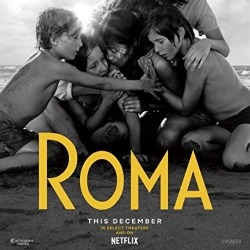
Professional filmmaking. That is one thought I had after coming out of this movie. As much as the story felt heartfelt and authentic (because it was), the film really showcased a director (Alfonso Cuaron) who knows his style, how to compose shots, and how to invoke authentic emotions. I go back and forth debating whether I think going with black and white was truly needed, but one thing is for certain in that it helps give the film a “timeless” feel to it. One that I know he thought about when making it, in that I believe he did not want to simply capture a snippet in time, but rather focus on the story and characters at hand, one which generations to come would relate to in their own way.
7. Shoplifters
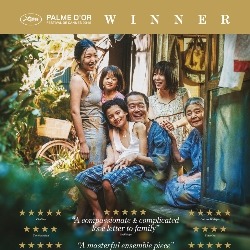
This was another foreign film that had a timeless feel to it. It’s always nice to watch foreign films, for a multitude of reasons, but in particular to be immersed in another culture for a brief period of time. That is certainly the case in this film, as the production design and sets do an outstanding job of putting you right into this world and help establish the atmosphere which helps understand the characters motivations and story a little more. The film had a unique plot and great acting, and the pacing felt very natural and thought out.
6. If Beale Street Could Talk
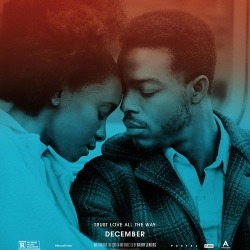
I love the way dialogue is shown in this film. The composition of the shots, the intensity of the delivery, everything is heightened when there is dialogue in this film. And it is imperative that this be the case, as this is what drives the fairly simplistic plot along. This is certainly a film that shows more than it says, but Barry Jenkins does that extremely well in this case as he does a good job of portraying the themes in subtle ways that give the audience just the right amount of room to interpret themselves. It is always a difficult balancing act, in dialogue heavy films, to spell things out too much or show too little leaving audiences lost. Another aspect this film does well is the music. The score is imperative in setting the mood in atmospheric, melancholic movies such as this one, and Nicholas Britell does a fantastic job creating a nuanced, rich, and evocative score, and implementing at opportune moments throughout the film. There are some directors that just “click” when watching their films. Barry Jenkins is starting to become one of them.
5. The Favourite
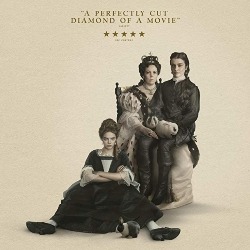
One of the best part of watching movies (or art in general) is when you see something truly unique that it changes your perspective on what you like or how it can be portrayed. For Yorgos Lanthimos, his films have changed my perspective on comedy and how I feel it can be portrayed. His films have the shell of a distinguished drama, but the core of a slapstick comedy. I never knew comedy could be so funny and portrayed so differently than how he does it, in particular here in The Favourite. The acting, writing, and plot all work seamlessly together to create genuinely hilarious moments all while advancing the story, developing strong characters, and establishing strong themes that lead to a wonderfully crafted ending, wrapping up the film in a beautiful way. I can’t say enough good things about this film, and am in awe at how someone can craft a style and execute it so brilliantly in such a short amount of time (just 3 films to date). He’s certainly made the list of “directors I will see films they release no matter what unless they make 3 bad movies in a row.”
4. Spider Man: Into The Spider Verse
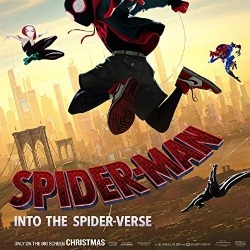
I have admittedly been far behind on my superhero movies, but I got a recommendation to see this one and I am extremely glad I did. I hope, when we look back at this decade of films, this one is the example of how much animation has grown over the years. The colors, the creativity, and even the technicality of it are all showcased in this film, but what makes this film so great is that it does not rest on just this alone. The characters, even with the high amount of them, are all relatable in some way, contribute to the story in their own unique way, and help establish this film as one different than any other superhero movie. The film does an excellent job of crafting a story truly fit for anyone, and it is a great film to discuss with others because they will certainly have a different way to relate to the story/characters. So that is a not so subtle suggestion to not only watch this film but tell others about it and talk about it with them!
3. Isle Of Dogs
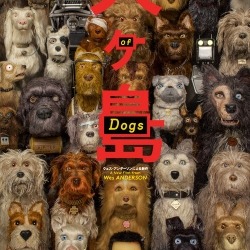
This list is just starting to sound like an expose on my favorite directors, but it is hard not to talk about the director for this film, because it is so inherently Wes Anderson-ian. I find it incredible that he can utilize his techniques and creativity in similar ways for such nuanced and unique stories. Characters are always at the root of his stories, and there are no shortage of good ones here. He has an uncanny ability to write and craft characters around the voice actors as well, as it is so seamless in the way the voice acting portrays the characters in this film. His writing style never ceases to garner guffaws throughout the film, and I am always impressed with the amounts of twists and turns the story takes. It is a craft he has certainly mastered and one that makes it easy to just sit back and enjoy everything that unfolds before your eyes. The film does a great job of being topical as well, with underlying satire that is tastefully done and never over the top. Wes Anderson’s movies are always so dense that it’s so easy to watch over and over again and find new things to fall in love with. It’s one of the reasons why he’s one of my favorite directors and also on the list that I mentioned above, although I’m starting to think it’s pretty unlikely he’ll make a movie I dislike.
2. Free Solo
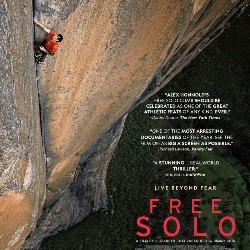
After the initial shock you have when trying to comprehend the magnitude of the athletic feat Alex Honnold is trying to accomplish, you start to shift your attention to the filmmaking. And that is almost (ok, not really) as impressive. The shots need to do the scale justice, and I think they did an excellent job of not only crafting a well shot film but also immerse you in this world many of us cannot even comprehend. I think they also do a good job of outlining this as much of a character study than anything, because it really is imperative to showcase the reasoning behind his actions, just for us mere mortals to understand a little better. And it turns out, in my eyes, he is just a supremely motivated individual seeking perfection and solitude. And as a result it is easy to come out of the movie exhilarated, energized, and motivated to accomplish any goals you may have. It’s a mark only a true story could do. Even if everything he does is so hard to believe.
1. Won’t You Be My Neighbor?
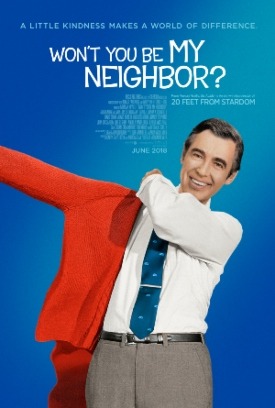
“If you want to truly do a bio-pic justice, just make a documentary.”
I made that statement after watching Bohemian Rhapsody, but the juxtaposition between that film and this one even more so justifies that statement. I won’t get into my thoughts on Bohemian Rhapsody, but I will just say that the documentary medium is really the only way to do Fred Rogers’ story justice, just so that you can show audiences, in this day and age, someone like that really did exist.
I will preface by saying I did not watch Mr. Rogers very often as a kid growing up. I knew when it was on, but I was more into Arthur and Wishbone on PBS. I also think the timing was everything, as there was a limited window to watch TV (cough I mean do homework) after school before my parents came home. And that’s ok, for his story does not need to be fully appreciated by watching him as a kid. Sure, I would love to go back to my childhood and sit down and watch him through the eyes of my inquisitive, imaginative young self, but I think no matter how or when you digest his story or listen to his words, you will wholeheartedly appreciate who he was and what he stood for.
I really started to take a deeper dive on him in high school, when he had just passed away and there were news stories on him. I watched some youtube videos and gained an appreciation for what he did, but it was only when I was thrust into a situation where I had an impact on another kid did I feel like his story was more pertinent and important than ever. I mentored an elementary school kid through the national honor society for 2 years during high school, and as an introvert, that terrified me. What scared me more was that these kids were there for a specific reason, either hardship at home or just needing someone there in their lives. I did not know how to communicate to people older than me, let alone people younger than me. I didn’t know what to do. So I remembered what Mr. Rogers would do. He would talk to kids like his equals. And I did just that. I would play games, run around in the snow making snowmen, make arts and crafts (many of which his was better than mine), and just try to take his mind off of things. If I felt like it was appropriate, I would ask him how things were going. He wouldn’t always answer at first, which was fine, but once he got more and more comfortable with me around, he would open up a little bit at a time. And believe me, just that little bit was some of the most rewarding moments I have had in my life. It wasn’t a normal feeling of success or accomplishment either. It was a feeling of unparalleled joy by seeing someone else happy and growing as a human being.
Joey, if you’re reading this, just know that I miss you, hope you are doing well, and I hope you continue to instill the values that Mr. Rogers had on others around you as well.
That was the power of Mr. Rogers. The power of being an inherently good, kind individual was a weapon we could use in times of struggle or hardship. Being a decent, respectful individual has gotten me more than any textbook or class ever did (not to say those aren’t important). It’s just that life is made up of all the relationships you have with people. The memories you have. The friendships. The laughter. The fights. The adventures. All made better by people at your side, and all made better (and easier) by living it with kindness in your heart.
They say that a mark of success is to leave an impact on society. Well I would say that Mr. Rogers did that and much more, as he will hopefully force society to to teach the next generation to be better, which in turn will teach the generation after to be even better than the one before. It’s the best pyramid scheme ever invented.
Even as I grow older, I will always refer to him as Mr. Rogers. I will always look up to him, and I don’t know if I could ever duplicate what he did at that grand of a scale which his accomplishments were. But if I just impact a few people in my life, and live it with joy, imagination, kindness, and respect, I think even he would say that’s a job well done.
The word neighborhood has always had a positive connotation in my life. Growing up, that meant friends, sports, sleepovers, endless summer nights, and no worries. Now, I associate that word with childhood, friends, kindness, respect, and joy.
And Mr. Rogers.
Thanks, Mr. Rogers.
0 notes
Text
The Hate U Give
“The Hate U Give Little Infants Fucks Everybody.” The phrase originally made popular in the ’90s by Tupac as an acronym for “THUG LIFE,” inspired another work of art, Angie Thomas’ debut novel, The Hate U Give. The book so successfully connected with a young generation grappling with gun violence and police brutality that it has remained on The New York Times’ bestseller list since its release in February 2017. Now, the film adaptation of its powerful story will attempt to reach an even bigger audience with its Black Lives Matter message.
Advertisement
Both the book and movie follow Starr Carter, a black teenager well-versed in code-switching between her black community in Garden Heights and the prep school her parents send her and her siblings to in the ostentatiously white and wealthy Williamson neighborhood. When the audience first meets her in George Tillman Jr.’s film, her stern-voiced dad, Maverick (Russell Hornsby), is teaching his children what to do if a police officer stops the car they’re in. Put their hands on the dashboard; do as they say. It’s the difference between life and death. She is nine-years-old in this scene, her older brother is ten and the youngest member of the Carter family is just a year old, still fussing in his mother’s arms.
The story then jumps forward to when Starr (Amandla Stenberg) is a vibrant 16-year-old who plays on her school’s basketball team and finds love in a goofy yet earnest white classmate named Chris (K.J. Apa). But the unintended consequence of having one foot in two different social circles is that you never really feel balanced in either. She feels out-of-place both at her white prep school where white kids love to use black slang and at a neighborhood party her friend brings her to so Starr can help her out in a fight. Starr’s awkward feelings are pushed aside for a moment when an old childhood friend and first crush, Khalil (Algee Smith), approaches her with a smile completed by dimples. A fight breaks out at the party, interrupting their meet-cute, and the two drive off in Khalil’s car. On their way back to Starr’s home, the two teens reminisce about old times and even share a kiss. Then, red and blue lights flash. A cop pulls them over for some unexplained reason, and Khalil gets defensive. Starr tries to coach him through her father’s warnings: hands on the dashboard, do what they say. When the cop walks away to run Khalil’s license, the teenager carelessly reaches for his hairbrush to pass the time. Shots ring out, killing Khalil. The officer handcuffs Starr next to her dying friend. He had mistaken the hairbrush in the boy’s hand as a weapon and shot first before asking any questions.
The event is a seismic one for the community and for Starr, who finds herself swept up in the media frenzy and the outrage. She suffers from post traumatic stress and seems to wander the halls of her school, unsure of what’s she doing there at all. Although only a short drive away, her classmates seem entirely disconnected from the problems facing the neighborhood next door. This exasperates Starr, and she begins breaking rank from one of her white girlfriends who really doesn’t understand what’s going on. Her boyfriend, Chris, stumbles through a crash course in how to be an alley, trying his hardest to help her.
Advertisement
The movie feels instructional without getting too preachy, taking time to explain various inequalities and barriers facing black Americans, typically in exchanges between father and daughter. In learning the ways of this unjust system, Starr decides not to accept things the way they are. Her outlook reflects the kind of youth-led movements that have sprung up from Black Lives Matter and the marches against gun violence in schools. The status quo just simply won’t go unchallenged this time.
Stenberg, whose previous credits include other YA fare like “The Hunger Games” and “Darkest Minds,” carries the difficult part well, growing from a carefree teen to traumatized kid to a natural born leader before our eyes. She’s hardly alone in her efforts as the supporting cast includes Issa Rae, Anthony Mackie and Common. As Starr’s parents, Hornsby and Regina Hall also share a nuanced and complicated dynamic—a loving couple who feel differently about how best to raise their children, in the difficult neighborhood in which they grew up or elsewhere.
To visually mirror the experience of switching between the worlds of Garden Heights and Williamson, the lighting and color of the scenes also change from warm, familiar tones (Garden Heights) to washed out blue hues (Williamson). The scenes in the Carter household look inviting and well lit, bringing to mind the comfort of a loving family. When Starr is at school, her face looks washed out and pale, as if the screen was trying to mute the colors of everyone’s skin to look the same. She tries so desperately to fit in this environment, she sacrifices who she is in more ways than just avoiding using the slang terms her classmates have co-opted.
In my screening of “The Hate U Give,” there were tears, gasps, laughter and cheers. A shiver rippled through my skin when the shots rang out, and I choked back sobs in many more scenes. It may be a popular movie with arguably simple messages, but it delivers them in emotionally effective ways. We feel for Starr and we are with her in moments like when she confronts a racist friend or questions a reporter for fixating on Khalil’s checkered past. We get a sense of the isolation she feels in her school’s hallway and when she’s forced to watch her friend bleed to death. If the story ever feels too basic, too “intro to race in America,” it’s because this is the story of a 16-year-old girl who’s learning that the world is even worse than what she knew. In the audience, there will likely be many more girls who will either be hearing a story like Starr’s for the first time or recognizing their experience onscreen for the first time.
Advertisement
Source: https://bloghyped.com/the-hate-u-give/
0 notes
Photo

New Post has been published on http://www.classicfilmfreak.com/2017/12/28/dark-corner-1946-starring-lucille-ball-mark-stevens/
The Dark Corner (1946) starring Lucille Ball and Mark Stevens
“There goes my last lead. I feel all dead inside. I’m backed up in a dark corner, and I don’t know who’s hitting me.”—Bradford Galt (Mark Stevens)
First, throw together, or rather carefully conceive and choreograph, a street thug, a couple of society criminals, a duplicitous wife and a pair of opposite personalities for partners—a pessimistic detective and his pretty, upbeat secretary. Now add the no-nonsense direction of Henry Hathaway, the chiaroscuro cinematography of Joseph MacDonald and the hard-nosed screenplay of Jay Dratler and Bernard Schoenfeld and the result is a succulent little film noir . . . The Dark Corner.
20th Century-Fox made some of the best noir films during that gold-mine period of the 1940s and early ’50s. True, the best of Warner Bros. are hard to beat—The Maltese Falcon (1941), The Big Sleep (1946) and White Heat (1949)—and are, perhaps, more famous. But Fox, though they started later, did have Laura (1944), The House on 92nd St. (1945), Nightmare Alley (1947), Call Northside 777 (1948), Where the Sidewalk Ends (1950) and any number of others.
Some of the featured stars seemed perfect for the genre—Richard Widmark and Richard Conte—and others, generally trademarked in heroic or comic roles—Tyrone Power and James Stewart—became as effective as anyone slipping among the dark shadows and sleazy joints of film noir.
The Dark Corner is often overlooked, but it clearly belongs, if not among the best, then among the more interesting of Fox’s explorations of bleak atmospheres and paranoid souls. Against the all-convincing angst of, say, a Humphrey Bogart, Mark Stevens as the miserably disheartened detective may be too negative to convey a strong character that sometimes depresses the audience in the process. Two other stars, one playing against type and the other reviving the character that brought him stardom, easily steal a greater portion of the limelight from Stevens.
People forget that Lucille Ball had been in the movies since 1933, only receiving consistent screen credit beginning in 1937, making mostly unremarkable movies and numerous comedies. Even opposite some of the big male stars—William Holden, Fred Astaire, Bob Hope, Ray Milland, Red Skelton—the result was little recognition. Little, that is, until the rocket success of I Love Lucy and a career that was largely devoid of theatrical movies, and forever away from dramatic roles for which she had a certain flair.
In The Dark Corner she is confident and vivacious, taking charge, often encouraging her gloomy detective-boss when he himself seems ready to give up. No revelation can weaken her devotion to him—not even him telling her he once served two years in prison for manslaughter, framed by one of the story’s characters, who plied him with scotch and put him behind the wheel of a car that hit and killed a truck driver.
The other scene-stealing actor, with perhaps more charisma, more nuances in his facial expression and certainly wittier than Mark Stevens, whose forte is hardly witticisms, is Clifton Webb. He had made a few movies since 1917 before gaining recognition in his first sound film, Laura.
Once again the actor is playing the sophisticated, erudite intellectual, a warmed-over Waldo Lydecker from the earlier Laura, there a newspaper columnist and radio host, now, in The Dark Corner, art devotee and gallery owner Hardy Cathcart. And from that same year, 1946, Webb is the snobbish dinner host in The Razor’s Edge. Years later, in 1954, Webb would be the expatriate author in Rome, John Frederick Shadwell, another eccentric with a way with words.
In The Dark Corner, Webb’s barbs are priceless. Isolated from this particular film, they could come from any number of his films. To one of his partners in crime: “The wife of the Austrian critic. She looks like she’s been out in the rain feeding the poultry.” And later to the same man: “How I detest the dawn. The grass always looks like it’s been left out all night.” Commenting on the party crowd gathering at his home: “A nauseating mixture of Park Avenue and Broadway. It proves I’m a liberal.”
Immediately after, once again, 20th Century-Fox’s unofficial theme song, “Street Scene,” behind the main title, MacDonald’s ever-distinctive camera swings down from a passing El train to an overhead shot of a man in a white suit (William Bendix) leaning against a lamppost. As the noise of the train vanquished the Alfred Newman tune, now only street noises remain. The white suit is eyeing a painter, who has about finished lettering a second-story window, “Bradford Galt, private detective.”
As a man, obviously not in a white suit, climbs the stairs and enters the Galt office, dark shadows and his wary glances imply criminal intent. He is, however, Police Lieutenant Frank Reeves (Reed Hadley), come to warn Galt to stay on the “straight and narrow,” now restarting his private eye business after that prison time. In meeting Kathy (Ball) and inquiring about Galt, she answers tartly, “I sharpen pencils, do the typing, answer the phone and mind my own business.” (In Hadley’s few scenes, he has a mystique somehow stronger than Stevens’, and it could be wondered how he would have been as Bradford Galt.)
After Reeves has left, Galt invites Kathy to dinner. “Is this part of the job?” she asks. “It is tonight.” “Working conditions,” she adds, “are certainly looking up around here.”
As they play games at an arcade—she beating him—their quick badinage continues (the audience can clearly sense an attraction between the two, certainly on her part). She would make a fine detective: she leans over to warn him of a man in a white suit who has been following them. “Yeah, I know,” he replies. Ah, he might make a detective, too!
And so the plot continues, gradually darkening in noir fashion, marked by four scenes of violence. After the arcade scene, Galt doubles back to surprise white suit with a gun. In his office, Galt throws the man against a wall and uses a choke-hold to wring information from him. The name he provides is Fred Foss, later revealed as Stauffer.
After Cathcart has overheard and seen on the floor the shadow of his wife Mari (Cathy Downs) kissing Jardine (Kurt Kreuger), he sends Foss to kill Jardine. The fireplace poker Foss used, he places in Galt’s hand after he has rendered the detective unconscious with ether.
Foss naively agrees to meet Cathcart on the thirteen floor of a skyscraper for his payoff. When Foss stoops to pick up a paper intentionally dropped by his boss, Cathcart shoves him out the window.
In the film’s final set piece in the art gallery, Cathcart confronts his wife, who has stashed her luggage, waiting for the never-to-arrive Jardine and their planned escape together. Cathcart, aware of Mari’s infidelity and speaking only in innuendo, delivers his final epigram: “Love is not the exclusive province of adolescence, my dear. It’s a heart ailment that strikes all age groups—like my love for you. My love for you is the only malady I’ve contracted since the usual child diseases. And it’s incurable.”
Galt has gained access to the gallery under the pretense of buying a $40,000 statue, but Cathcart pulls a gun and is about to kill him when Mari, in stark silhouette from the top of the stairs, shoots him dead. Webb’s wide-eyed, surprised expression as he collapses recapitulates Waldo Lydecker’s demise in Laura.
The “Street Scene” melody, absent from the soundtrack since the main title, returns as Kathy and Galt leave for city hall and the justice of the peace. She tells Reeves, who is there to congratulate Galt, “Brad hasn’t asked me yet, but I told him from the beginning I was playing for keeps.”
The plot of Dark Corner is just short of complicated, complex enough to keep the audience guessing. In the ’40s, no studio could do better than Fox in the luscious, often extravagant contemporary interiors, with brilliant chandeliers, curving staircases and elegantly attired guests.
Good and attention-holding, but not first tier among the studio’s noir films. While sharp and succinct, the dual script of Dratler, who co-wrote Laura, and Schoenfeld could have been more original, less, at times, a compendium of noir clichés. The acting is generally quite substantial, especially from Ball, Webb and Bendix, though Cathy Downs is nothing more than a bland ornament on screen and Mark Stevens could have invested a little more drama, dynamism and humanity in his role.
youtube
0 notes
Text
The 20 Best Movies of 2017 (So Far)

When it comes to collating the best movies we’ve seen so far in 2017, we did our damnedest to not only give a general consensus among our section’s staff, but to keep in mind which films our readers will actually be able to catch in theaters. Two of these picks premiered at Cannes last year, but only recently scored some U.S. distribution, and one title won’t come out for another few weeks which, as of publishing, has only been seen (and adored) by one person on staff. All excuses of course: With writers spread out all over the world, and with something like 3,000 film festivals currently active, the number of great movies on our individual lists splays out far too broadly to be limited by a few months.
So, there’s something for everyone in the following: big budget crowd-pleasers, obligatory sequels, obligatory franchise installments, historical dramas, anime fantasy, both urgent and meditative documentaries, both urgent and meditative genre debuts, a social drama that’s also a kaiju film, a social drama that’s also a bit of a farce, and an unclassifiable ghost story or two. Here’s to hoping you can find a film to truly love in 2017.
Here are the 20 best movies of 2017—so far.
20. The Fate of the Furious
Director: F. Gary Gray
The Fate of the Furious is the reason moving pictures exist. Not the only reason, just the main one: the glory of dynamic motion which involves the pulse and the heart. The Fast franchise is a group of action films centered around a crew of talented outlaws who engage in illegal street racing and, later, heists. Although the lineup has changed over the years, the basic formula has stayed the same: an eccentric crew of colorful characters with various talents, led by Dominic Toretto (Vin Diesel) and his co-conspirator/girlfriend/wife Letty Ortiz (Michelle Rodriguez) get involved in ever-increasing stakes. This group refers to themselves as “family,” and their bond is the sinew of the franchise. As the series escalates—escalation is the name of the game here—everybody eventually becomes part of the family, even the antagonists who are sent after them: the first movie saw undercover cop Brian O’Conner (Paul Walker) joining the crew; this habit is followed in later movies by Diplomatic Security Service agent Luke Hobbs (Dwayne Johnson). But none of this dry summation can give you an accurate idea of this franchise or its charm: These are movies where topping the previous installment is itself the art. How much crazier can the stunts get? How strong is the family’s bond? How many incredible moments will these stars have on screen? How intense can the stakes get? How byzantine are the plots? How can they possibly pull it off? The Fast franchise, and its latest installment, Fate of the Furious, is so clever, so perfectly executed, emotionally sincere, self-aware and gloriously cinematic that I think it’s made me happier, and more entertained, than any other movie I’ve seen this year. —Jason Rhode / Full Review
19. I Called Him Morgan Director: Kasper Collin
I Called Him Morgan is the story of two troubled people, one of whom killed the other. Documentarian Kasper Collin—who previously made My Name Is Albert Ayler, also about a jazz musician—looks at the difficult, abbreviated life of trumpeter Lee Morgan, who was shot dead in the winter of 1972 in New York. It’s not a mystery who pulled the trigger—it was his common-law wife, Helen, who was more than 10 years his senior—but I Called Him Morgan isn’t about solving a crime, rather, it’s about connecting the dots regarding why the crime happened. Throughout the film, you feel the slow, grim pull of inevitable tragedy set against a lush visual palette. (Oscar-nominated Arrival cinematographer Bradford Young is one of I Called Him Morgan’s credited cameramen.) Talking heads’ tales are crosscut with dreamy images—snowy nights in New York, a hypnotically colorful fish tank—that always feel pertinent to what’s being discussed. And then there are the interview subjects and the milieu. Jazz musicians such as Wayne Shorter and Charli Persip talk about their friend with specificity and insight, and Lee Morgan’s music—as well as the music he played in other people’s bands—fills the soundtrack. The film will be heaven for jazz aficionados, but those who don’t know the difference between bebop and hard bop won’t feel lost. Collin understands that his film is about people, not art, but his deft storytelling—and the endless sadness that comes from his tale—flexes its own nimbleness and beauty. —Tim Grierson / Full Review
18. T2 Trainspotting Director: Danny Boyle Superficially, T2 is an action crime comedy, but its true subject is about being 40 in the modern United Kingdom, just as its predecessor was about being British and 20. Boyle and company want to both eat and burn their cake, too—to be nostalgic and deconstruct nostalgia. The plot, which deals with payback and schemes, is really an excuse for all of us to check in, keep tabs, see how everybody is doing. There are flashbacks to scenes from the original movie, and childhood scenes that weren’t in the original film. T2 is mostly played out in the aged faces of its lead characters as they stumble over the twilight of youth: Aye, so it’s come to this; a real shame, innit? —Jason Rhode / Full Review
17. Logan Director: James Mangold Ultimately, Logan’s ambition is to present itself with a weight of gravitas that isn’t entirely earned, considering the history of the character. It will doubtlessly frustrate some of the Everyman cinema-goers who perceive its middle chapters as slow, or who criticize the 135-minute run-time, but I expect patient viewers will appreciate the way it allows its characters to breathe and wallow in moments of vulnerability. It’s not a film calculated to be a people-pleaser, but it is an appropriately intense end to a character defined by the tenacity and ferocity of a wolverine. —Jim Vorel / Full Review
16. City of Ghosts Director: Matthew Heineman There need not be a documentary about the Syrian catastrophe to rally the world around its cause—just as, in Matthew Heineman’s previous film, Cartel Land, there was no need to vilify the world of Mexican cartels or the DEA or the paramilitaristic nationalists patrolling our Southern borders to confirm that murder and drug trafficking are bad. The threats are known and the stakes understood, at least conceptually. And yet, by offering dedicated, deeply intimate portraits of the people caught up in these crises, Heineman complicates them beyond all repair, placing himself in undoubtedly death-defying situations to offer a perspective whose only bias is instinctual. So it is with City of Ghosts, in which he follows members of Raqqa is Being Slaughtered Silently, a group committed to using citizen-based journalism to expose the otherwise covered-up atrocities committed by ISIS and the Assad regime in Syria. In hiding, in Turkey and Germany and at an event for journalists in the U.S.—in exile—these men, who Heineman characterizes as a very young and even more reluctant resistance, tell of both the increasingly sophisticated multimedia methods of ISIS and their hopes for feeling safe enough to settle and start a family with equal trepidation about what they’ve conditioned themselves to never believe: That perhaps they’ll never be safe. Heineman could have easily bore witness to the atrocities himself, watching these men as they watch, over and over, videos of their loved ones executed by ISIS, a piquant punishment for their crimes of resistance. There is much to be said about the responsibility of seeing in our world today, after all. Instead, while City of Ghosts shares plenty of horrifying images, the director more often that not shields the audience from the graphic details, choosing to focus his up-close camera work on the faces of these men as they take on the responsibility of bearing witness, steeling themselves for a potential lifetime of horror in which everything they know and love will be taken from them. By the time Heineman joins these men as they receive the 2015 International Press Freedom Award for their work, the clapping, beaming journalists in the audience practically indict themselves, unable to see how these Syrian men want to be doing anything but what they feel they must, reinforcing the notion that what seems to count as international reportage anymore is the exact kind of lack of nuance that Heineman so beautifully, empathetically wants to call out. —Dom Sinacola
15. John Wick: Chapter 2 Director: Chad Stahelski Perhaps the greatest compliment you can pay to both John Wick movies is via comparison to a contemporary: John Wick films are to guns what The Raid films are to fists. Within their respective spheres of combat, each is on an entirely separate level in terms of presentation. Both aspire to something more vital than to “entertain.” They don’t want to “satisfy” an audience—they want to make your jaw drop. They want you to stifle a guffaw as John Wick (Keanu Reeves) pulls off a move that is simultaneously so slickly unrealistic and bone-crunchingly visceral that the cognitive dissonance causes a brief misfire in your synapses. They’re everything that G.I. Joe or Fast & The Furious never bothers even attempting to be. So yes, both cinephiles and action movie buffs will be pleased to know that John Wick: Chapter 2 is a worthy follow-up to the surprising 2014 original. Holding the torch passed from ’80s and ’90s John Woo classics, director Chad Stahelski delivers an epic ballet of arm-breaking and gun-kata that somehow manages to run for 122 minutes without ever overstaying its welcome. That’s far easier said than done. —Jim Vorel / Full Review
14. Prevenge Director: Alice Lowe Maybe getting close enough to gut a person when you’re seven months pregnant is a cinch—no one likely expects an expecting mother to cut their throat—but all the positive encouragement Ruth’s (Alice Lowe) unborn daughter gives her helps, too. The kid spends the film spurring her mother to slaughter seemingly innocent people from in utero, an invisible voice of incipient malevolence sporting a high-pitched giggle that’ll make your skin crawl. “Pregnant lady goes on a slashing spree at the behest of her gestating child” sounds like a perfectly daffy twist on one of the horror genre’s most enduring contemporary niches on paper. In practice it’s not quite so daffy, more somber than it is silly, but the bleak tone suits what writer, director, and star Lowe wants to achieve with her filmmaking debut. Another storyteller might have designed Prevenge as a more comically-slanted effort, but Lowe has sculpted it to smash taboos and social norms. Because Prevenge hates human beings with a disturbing passion—even human beings who aren’t selfish, awful, creepy or worse—in it, child-rearing is a form of real-life body horror that’s as smartly crafted and grimly funny as it is terrifying. —Andy Crump / Full Review
13. Starless Dreams Director: Mehrdad Oskouei Mehrdad Oskouei, the director of this sobering documentary about young girls in a juvenile-detention facility in Iran, is well-regarded in his home country, but until the Museum of the Moving Image in New York gave this film a theatrical run earlier this year, he was barely known, if at all, by international audiences outside of the festival circuit. Based on Starless Dreams, though—and especially in tandem with two earlier, shorter, similarly themed documentaries of his, It’s Always Late for Freedom (2007) and The Last Days of Winter (2011)—the belated wider attention seems richly deserved. A mix of talking-heads interviews and fly-on-the-wall observational sequences, Starless Dreams couches its critique of a heartless judicial system, and by extension a repressive society, in deeply human terms. The personal stories Oskouei, with his paternal manner, collects are heartbreaking in their evocation of childhood innocence crushed at a prematurely early age, with some of them either fearing returning to their normal lives outside of the facility, and others simply wishing for death. And yet, occasionally these girls are able to find pockets of light, mostly through the bonds they’ve forged with each other. Abbas Kiarostami may have left this earth last year, but his gently inquisitive spirit, at least in the nonfiction realm, finds a successor in Oskouei. —Kenji Fujishima
12. After the Storm Director: Hirokazu Kore-eda If a melancholy, troubled tone is endemic in Kore-eda’s work, so is his close chronicling of family dynamics. While Ryota fears turning into the same terminal disappointment as his father—or, perhaps, the disappointment he perceived him to be—he tries to win Shingo’s affection, buying him gifts to assert his supremacy over his ex’s new boyfriend. In Ryota’s mind, it’s how to be close to his boy in a way his father never was with him, but After the Storm knows better, recognizing all the ways that he’s failing his kid—and also how, like its own kind of genetic gravity, Ryota is becoming his old man, unable to correct the mistakes of the past. But there’s no scorn in Kore-eda’s depiction of Ryota’s transformation: The middle-aged man will come to understand how little he knew about his dad and also why he still craves connection to him, even though he thought he didn’t. —Tim Grierson / Full Review
11. Your Name Director: Makoto Shinkai In the great ongoing debate of anime canonicity at large, Shinkai is often heralded as the “next” Hayao Miyazaki for both the artistry and accessibility of his work. This comparison, however, albeit well-meaning, is reductionist. Miyazaki’s place in the history of anime is already well established, while Shinkai has not even yet reached his apex. The burden of expectation, to laud any one director as the “next” adoptive patriarch of their art form, is as misguided as it is creatively stifling. Art does not need successors; art needs artists. This much, however, is certain: Shinkai’s films speak directly to the times in which they were created, and with this latest work, he has more than earned the right to step from out of the shadow of comparisons to Miyazaki and forge his own name. —Toussaint Egan / Full Review
10. Casting JonBenet Director: Kitty Green An unlikely cross-section of humanity also populates Casting JonBenet, which boasts a provocative idea that yields enormous emotional rewards. Filmmaker Kitty Green invited members of the Boulder, Colorado community where JonBenet Ramsey lived to “audition” for a film about her. But in the tradition of Kate Plays Christine or The Machine Which Makes Everything Disappear, that’s actually a feint: Green uses the on-camera interviews with these people to talk about Ramsey’s murder and the still-lingering questions about who committed the crime. She’s not interested in their acting abilities—she’s trying to pinpoint the ways that a 21-year-old incident still resonates. It’s a premise that could seem cruel or exploitative, but Casting JonBenet is actually incredibly compassionate. Green wizardly finds connective tissue between all these actors, who have internalized the little girl’s killing, finding parallels in their own lives to this tragedy. High-profile murders like Ramsey’s often provoke gawking, callous media treatment, turning us all into rubberneckers, but Casting JonBenet vigorously works against that tendency, fascinated by our psychological need to judge other people’s lives, but also deeply mournful, even respectful, of the very human reasons why we do so. —Tim Grierson
9. It Comes at Night Director: Trey Edward Shults It Comes at Night is ostensibly a horror movie, moreso than Shults’s debut, Krisha, but even Krisha was more of a horror movie than most measured family dramas typically are. Perhaps knowing this, Shults calls It Comes at Night an atypical horror movie, but—it’s already obvious after only two of these—Shults makes horror movies to the extent that everything in them is laced with dread, and every situation suffocated with inevitability. For his sophomore film, adorned with a much larger budget than Krisha and cast with some real indie star power compared to his previous cast (of family members doing him a solid), Shults imagines a near future as could be expected from a somber flick like this. A “sickness” has ravaged the world and survival is all that matters for those still left. In order to keep their shit together enough to keep living, the small group of people in Shults’s film have to accept the same things the audience does: That important characters will die, tragedy will happen and the horror of life is about the pointlessness of resisting the tide of either. So it makes sense that It Comes at Night is such an open wound of a watch, pained with regret and loss and the mundane ache of simply existing: It’s trauma as tone poem, bittersweet down to its bones, a triumph of empathetic, soul-shaking movie-making. —Dom Sinacola / Full Review
8. Raw Director: Julia Ducournou If you’re the proud owner of a twisted sense of humor, you might tell your friends that Julia Ducournau’s Raw is a coming of age movie in a bid to trick them into seeing it. Yes, the film’s protagonist, naive incoming college student Justine (Garance Marillier), comes of age over the course of its running time; she parties, she breaks out of her shell and she learns about who she really is as a person on the verge of adulthood. But most kids who come of age in the movies don’t realize that they’ve spent their lives unwittingly suppressing an innate, nigh-insatiable need to consume raw meat. “Hey,” you’re thinking, “that’s the name of the movie!” You’re right! Allow Ducournau her cheekiness. More than a wink and nod to the picture’s visceral particulars, Raw is an open concession to the harrowing quality of Justine’s grim blossoming. Nasty as the film gets, and it does indeed get nasty, the harshest sensations Ducournau articulates here tend to be the ones we can’t detect by merely looking: Fear of feminine sexuality, family legacies, popularity politics and uncertainty of self govern Raw’s horrors as much as exposed and bloody flesh. It’s a gorefest that offers no apologies and plenty more to chew on than its effects. —Andy Crump / Full Review (for a slightly different take on the film)
7. Guardians of the Galaxy Vol. 2 Director: James Gunn In Guardians of the Galaxy Vol. 2, James Gunn shows that “second verse, mostly same as the first” can serve the viewer (and, inevitably, the box office) well, especially when one has most of the Marvel universe to pull from. To a large extent, GotG Vol. 2 follows the playbook from the first film, though now, with the entire cast familiar faces to the audience, Gunn skips introductions and goes right to the funny. In this case, that means an opening credits sequence featuring the entire team and what amounts to a highlight reel of character traits meant to amuse: rapid banter from Star-Lord (Chris Pratt) and Rocket Raccoon (Bradley Cooper), humorous ’roid-rage from Drax (Dave Bautista), quiet bad-assitude from Gamora (Zoe Saldana) and an extended cute-Groot frolic. During this sequence and throughout the movie, the comic elements of this particular space opera feel as if they have been ratcheted up. But though he doesn’t seem to want the audience to have too much time between laughs, Gunn also seems determined to match the increased comic volume with more heart. The audience is unlikely to feel they’ve seen anything that different from Vol. 1, but it’s clear that Gunn and company knew exactly what qualities made the first film so enjoyable, and what they needed to do to make sure this particular sequel was worth the wait. —Michael Burgin / Full Review
6. Colossal Director: Nacho Vigalondo Colossal is simply a much darker, more serious-minded film than one could possibly go in expecting, judging from the marketing materials and rather misleading trailers. It blooms into a story about sacrifice and martyrdom, while simultaneously featuring an array of largely unlikable characters who are not “good people” in any measurable way. I understand that description sounds at odds with itself—this film is often at odds with itself. But in the cognitive dissonance this creates, it somehow finds a streak of feminist individuality and purpose it couldn’t have even attempted to seek as a straight-up comedy. —Jim Vorel / Full Review
5. I Am Not Your Negro Director: Raoul Peck Raoul Peck focuses on James Baldwin’s unfinished book Remember This House, a work that would have memorialized three of his friends, Martin Luther King Jr., Malcolm X and Medgar Evers. All three black men were assassinated within five years of each other, and we learn in the film that Baldwin was not just concerned about these losses as terrible blows to the Civil Rights movement, but deeply cared for the wives and children of the men who were murdered. Baldwin’s overwhelming pain is as much the subject of the film as his intellect. And so I Am Not Your Negro is not just a portrait of an artist, but a portrait of mourning—what it looks, sounds and feels like to lose friends, and to do so with the whole world watching (and with so much of America refusing to understand how it happened, and why it will keep happening). Peck could have done little else besides give us this feeling, placing us squarely in the presence of Baldwin, and I Am Not Your Negro would have likely still been a success. His decision to steer away from the usual documentary format, where respected minds comment on a subject, creates a sense of intimacy difficult to inspire in films like this. The pleasure of sitting with Baldwin’s words, and his words alone, is exquisite. There’s no interpreter, no one to explain Baldwin but Baldwin—and this is how it should be. —Shannon M. Houston / Full Review
4. Graduation Director: Cristian Mungiu The crimes are minor but it’s the misdemeanors that do the most harm in Graduation, an excellent Romanian drama that begins as a father’s hope for his talented teen daughter and morphs into a claustrophobic moral crisis ensnaring several individuals. Writer-director Cristian Mungiu lays out his story with nearly surgical precision, adopting a chilly tone for a movie about the tiny, day-to-day infractions that conspire to corrode society’s foundation. This is the fourth feature from Mungiu, who has proved to be a master of the minor. In his breakout second feature, 4 Months, 3 Weeks and 2 Days, the arduous process to secure an abortion was enough to sustain a taut, real-time thriller. In his 2012 follow-up Beyond the Hills, the tense relationship between two childhood friends became a springboard for a drama about religious faith and devotion. Now with Graduation, Mungiu again sees the drama in the everyday, arguing that it’s not the major injustices that are the most nefarious—it’s the small ways we screw over the other guy on a regular basis that keep us so paranoid and distrustful of one another. Rarely has cheating on a test been fraught with such significance. —Tim Grierson / Full Review
3. The Lost City of Z Director: James Gray James Gray’s The Lost City of Z is an anti-period movie. In the vein of The Immigrant, Gray’s glorious last film, Z is fascinated with its milieu (this time we begin across the Atlantic in Blighty, from 1906 to 1925) and luxuriously adorned with period detail—but the strangulated social climate and physically claustrophobic spaces of its ostensibly sophisticated Western society make that environment appear totally unappealing. Only once we reach the Amazon, untainted by Western hands, does the film relax, its beguiling score and open-air scenery turning inviting. There, in a land of uncomplicated tribes and indifferent wilderness, a man like soldier and explorer Major Percy Fawcett (Charlie Hunnam) can find freedom from the narrow-mindedness infecting early 20th century Britain. Darius Khondji’s cinematography doesn’t just complement Gray’s movie, it deepens its meaning, strengthening the appeal of Fawcett’s jungle, endlessly verdant and mysterious where home in England appears dull and monotone. Every frame is sumptuous and misty-eyed, always pining for a lost era when adventurers might still find corners of the Earth completely untouched. (Gray may show little love for Empire, but he depicts colonial exploration in itself as a romantic adventure.) The film doesn’t make for much complexity, but it feels deeply. Like Fawcett, it aches—like his obsession, the jungle, it envelops, casting a lasting spell. —Brogan Morris / Full Review
2. Personal Shopper Director: Olivier Assayas The pieces don’t all fit in Personal Shopper, but that’s much of the fun of writer-director Olivier Assayas’s enigmatic tale of Maureen (Kristen Stewart, a wonderfully unfathomable presence), who may be in contact with her dead twin brother. Or maybe she’s being stalked by an unseen assailant. Or maybe it’s both. To attempt to explain the direction Personal Shopper takes is merely to regurgitate plot points that don’t sound like they belong in the same film. But Assayas is working on a deeper, more metaphoric level, abandoning strict narrative cause-and-effect logic to give us fragments of Maureen’s life refracted through conflicting experiences. Nothing happens in this film as a direct result of what came before, which explains why a sudden appearance of suggestive, potentially dangerous text messages could be interpreted as a literal threat, or as some strange cosmic manifestation of other, subtler anxieties. Personal Shopper encourages a sense of play, moving from moody ghost story to tense thriller to (out of the blue) erotic character study. But that genre-hopping (not to mention the movie’s willfully inscrutable design) is Assayas’s way of bringing a lighthearted approach to serious questions about grieving and disillusionment. The juxtaposition isn’t jarring or glib—if anything, Personal Shopper is all the more entrancing because it won’t sit still, never letting us be comfortable in its shifting narrative. —Tim Grierson / Full Review
1. Get Out Director: Jordan Peele Peele’s a natural behind the camera, but Get Out benefits most from its deceptively trim premise, a simplicity which belies rich thematic depth. Chris (Daniel Kaluuya) and Rose (Allison Williams) go to spend a weekend with her folks in their lavish upstate New York mansion, where they’re throwing the annual Armitage bash with all their friends in attendance. Chris immediately feels out of place; events escalate from there, taking the narrative in a ghastly direction that ultimately ties back to the unsettling sensation of being the “other” in a room full of people who aren’t like you—and never let you forget it. Put indelicately, Get Out is about being black and surrounded by whites who squeeze your biceps without asking, who fetishize you to your face, who analyze your blackness as if it’s a fashion trend. At best Chris’s ordeal is bizarre and dizzying, the kind of thing he might bitterly chuckle about in retrospect. At worst it’s a setup for such macabre developments as are found in the domain of horror. That’s the finest of lines Peele and Get Out walk without stumbling. —Andy Crump
0 notes